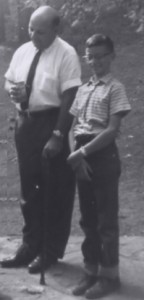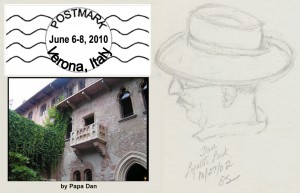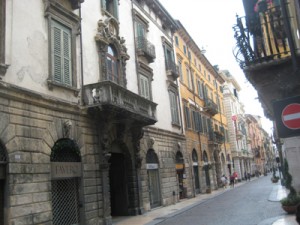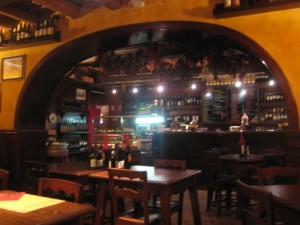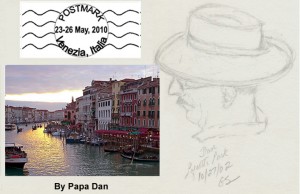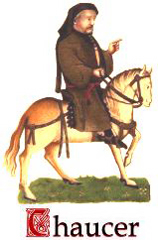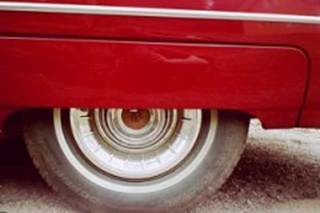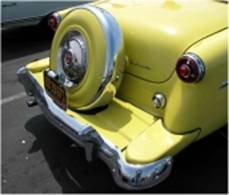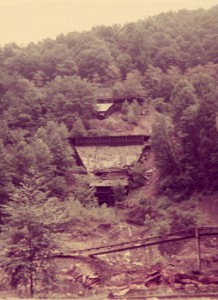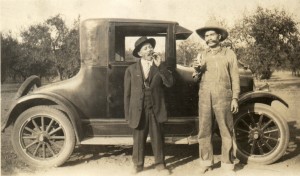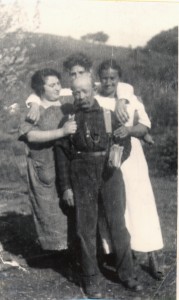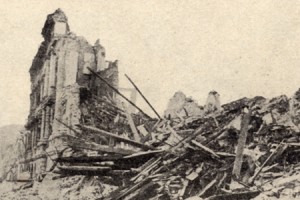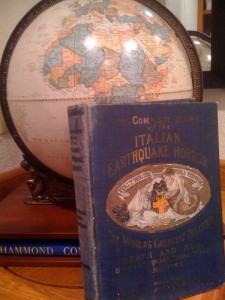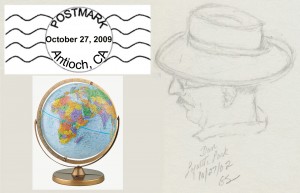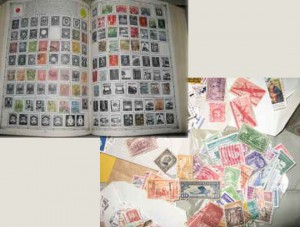Verona — In Search of Montegue, Capulet, and . . . Crollalanza?
Looking for ‘The Bard’ . . . in Italy?!
William Shakespeare is undisputed as the single greatest playwright and poet to write in the English language. From the sheer craft of the poetic use of language and imagery, to the creation of vivid characters for the stage from paupers to kings and everyone in between, to his ability to reveal simultaneously the complexity and simplicity of the human condition, he is the undisputed best the English language and the English-speaking culture has produced. So, why would a longtime student of Shakespeare such as myself, come looking for him here, in an ancient town in northern Italy half way between Milan and Venice? The easy answer is that two of Shakespeare’s most famous and distinct characters, Romeo and Juliet, lived here in Verona during their short lives on the stage at the Globe Theater around the turn of 17th-century in London. Giulietta, in particular, is an important part of the local mythology of this little town. In fact, we learned that people from all over the world still send letters to Giulietta here in Verona.
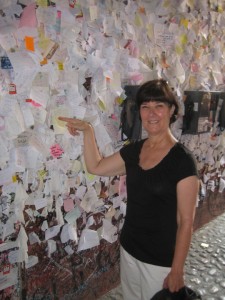
Letters to Giulietta are posted here in the courtyard of 'La Casa de Giulietta' near the Piazza Bra in Verona
How did she and her lover capture the imagination of so many of us?
Romeo Montecchi and Giulia Cappelle were probably real members of two families in Verona who hated each other quite a bit before Shakespeare’s time. A few scholars suggest that Shakespeare may have based his play on a story written by Matteo Bandello around 1550. Whether this story was the source of these actual characters we can only guess; but the Montecchi and Cappeletti families did live here and really did famously feud. Dante, while living in exile in Verona in the early 14th century, actually mentions their names as residents of Purgatorio, presumably as an example of where feuding families end up.
But this speculation does not answer my question, why should we look for Shakespeare himself here in the narrow alleys and ancient piazzas of this little Italian town?
And now for something completely different —
Since the accepted biographical details of the ‘Bard from Stratford’ do not place him anywhere near Verona, a number of questions are unavoidable — Where did this untraveled Englishman get this story? How did he learn so much about Veronese history and culture? Did this man with an undistinguished education write the play at all? Many scholars of this and other plays attributed to Shakespeare suggest other possible playwrights. While I am not going to enter that argument, I am going to start another one — are you ready?
Was Shakespeare Italian?
Over the centuries scholars have been puzzled by Shakespeare’s profound knowledge of things Italian. Shakespeare seemed to have an impressive familiarity with stories by Italian authors such as Giovanni Boccaccio, Matteo Bandello, and Masuccio Salernitano. In an attempt to solve the mystery of Shakespeare’s Italian aptitude, one former teacher of literature has unleashed a new hypothesis on a world eager to hear anything fresh about the Bard.
Retired Sicilian professor Martino Iuvara claims that Shakespeare was, in fact, not English at all, but Italian. His conclusion is drawn from research carried out from 1925 to 1950 by two professors at Palermo University. Iuvara posits that Shakespeare was born not in Stratford in April 1564, as is commonly believed, but actually was born in Messina as Michelangelo Florio Crollalanza. His parents were not John Shakespeare and Mary Arden, but were Giovanni Florio, a doctor, and Guglielma Crollalanza, a Sicilian noblewoman. The family supposedly fled Italy during the Holy Inquisition and moved to London. It was in London that Michelangelo Florio Crollalanza changed his name to its English equivalent. Crollalanza apparently translates literally, from Old Sicilian, as ‘Shakespeare’ (or ‘suddenly shaken or fallen lance’). Iuvara goes on to claim that Shakespeare studied abroad and was educated by Franciscan monks who taught him Latin, Greek, and history. He also claims that while Shakespeare (or young Crollalanza) was traveling through Europe he fell in love with a 16-year-old girl named Giulietta. But sadly, family members opposed the union, and Giulietta committed suicide.
Iuvara’s evidence includes a play written by Michelangelo Florio Crollalanza in the Sicilian dialect. The play’s name is Tanto traffico per Niente, which can be translated into ‘Much Traffic for Nothing‘ or perhaps ‘Much Ado About Nothing.’ He also mentions a book of sayings credited to Michelangelo Florio Crollalanza. Some of the sayings correspond to lines in Hamlet. And, Michelangelo’s father, Giovanni Florio, once owned a home called “Casa Otello”, built by a retired Venetian known as Otello who, in a jealous rage, murdered his wife.
Granted, these similarities between Michelangelo Florio Crollalanza and Shakespeare are intriguing, but for now I remain unconvinced. That Shakespeare was Italian sounds as credible as the idea that Queen Elizabeth I wrote Shakespeare’s works when she was not busy tending to the realm. And I am not alone in my cynicism. While some Shakespearean scholars, most of whom are Italian themselves, are quick to support the hypothesis, the majority are skeptical, to say the least. Although the following excerpt from a biography of Shakespeare by Sir Sidney Lee is not a direct response to Iuvara’s claims, it does illuminate briefly the other side of the argument:
“It is, in fact, unlikely that Shakespeare ever set foot on the Continent of Europe in either a private or a professional capacity. He repeatedly ridicules the craze for foreign travel. To Italy, it is true, and especially to cities of Northern Italy, like Venice, Padua, Verona, Mantua, and Milan, he makes frequent and familiar reference, and he supplied many a realistic portrayal of Italian life and sentiment. But his Italian scenes lack the intimate detail which would attest a first-hand experience of the country. The presence of barges on the waterways of northern Italy was common enough partially to justify the voyage of Valentine by ‘ship’ from Verona to Milan (‘Two Gent.’ I.i.71). But Prospero’s embarkation in ‘The Tempest’ on an ocean ship at the gates of Milan (I.ii.129-144) renders it difficult to assume that the dramatist gathered his Italian knowledge from personal observation. He doubtless owed all to the verbal reports of traveled friends or to books, the contents of which he had a rare power of assimilating and vitalizing.” (Lee 86)
“It was not unusual for an Elizabethan dramatist to set his or her play in Italy. Are we, knowing this, compelled to assume that Marlowe, Bacon, and Jonson were Italian?”
“Admittedly, we do not have much information about Shakespeare’s education, but why is it easier for Iuvara to assume that Shakespeare was an Italian refugee than it is to assume that he mastered Italian culture and history on his own? Jonson’s verses in the Folio identify Shakespeare as the ‘Sweet Swan of Avon’, and his birth record and other important documents attest to the fact that Shakespeare was a resident of England his whole life. Yet some choose to ignore these pieces of evidence in favor of more esoteric theories. One thing is certain – Iuvara’s claim that Shakespeare was Italian will unite Shakespeare supporters and anti-Stratfordians from the camps of Bacon, Essex, Marlowe, Derby, Rutland, Oxford, and Queen Elizabeth in a mutual uproar.”
Further Reading
Lee, Sir Sidney. A Life of William Shakespeare. New York: Dover Publications, 1968.
Based on : Was Shakespeare Italian? Shakespeare Online. 20 Aug. 2000. http://www.shakespeare-online.com/biography/shakespeareitalian
===================
OK, so there you have it — a perfectly ridiculous idea that is the direct result of spending a few days in Verona. It can have that effect on a person. After a few terrific dinners and bottles of local wine in the little restaurants tucked away in the alleys of Verona (two of the best restaurant experiences we’ve had in Italy) and it’s not so difficult to imagine all sorts of stories that put this little town firmly in the center of the universe.
So, why do so many Shakespearean scholars in Britain go to so much effort to refute such an outlandish idea? To use some of the Bard’s own words, “Methinks they dost protest too much.”
Vienna, Austria: City of Musicians
Vienna: Grand, Fun, Musical, and Tasty
I have said many times that my love of travel has most often been focused on small towns and villages — Varenna, with it’s population of 800, first among them — as opposed to the major cities that seem to occupy the most space in travel sections of newspapers and bookstores. But a handful of cities has risen to a short list of ‘favorite’ places we have visited; and Vienna is one of them.
We had the advantage of staying in a lovely suite in a small hotel, Pension Nosek, with two balconies hanging directly over Vienna’s wonderful Graben (pronounced GRAH-ben). The Graben is regularly transformed from a near-deserted pedestrian square to a bustling festival of music, jugglers, mimes, and horse carriages. (Pictures will be added later.) It is a neighborhood that seems to know how to have a good time without being too loud or intimidating.
For the ‘Fashionistas’ among us (and you know who you are), a stroll down the Graben and its side streets provides a window-shoppers paradise with all of the Louis Voiton, Geox, Versace, Cartier, etc, you would find on the Champs Elyses, Rockefeller Center, Florence, or San Francisco. On this street, you can see dozens of:
2,500-euro dresses
700-euro blouses
500-euro purses
400-euro pairs of shoes
to choose from ($1.21 = 1 euro today).
I was delighted each time we walked away from one of these.
Music
Vienna has been known as the city of musicians for hundreds of years and the name still works. Mozart is everywhere — his music as well as Mozart look-alikes selling tickets to tonight’s performance.
Before we left home, we did something we recommend — ordered tickets months ago to a concert at Vienna’s magnificent Musikverein (a photo is in my email). The most beautiful of it’s four concert halls — The Golden Hall — is worth the price of admission just to sit and look up at it for two hours, soaking up its loveliness. When we sat down and said aloud, “This is beautiful!” an older lady sitting behind us at our terrific seats told us, “and it is very old, 1817, and was not destroyed.” In Vienna, which has been in the midst of much modern warfare, the expression “was not destroyed” is used with great feeling. The golden interior design and sparkling chandeliers are breathtaking.
As for the music, I ordered our tickets based on the date we would be there and a performance of the Vienna Philharmonic in the beautiful Golden Hall. The specific musical program was not my choice. I will say only: the twentieth century produced some brutal music. The pieces we heard successfully conveyed the tension, fear, and unresolved dissonance of war-torn Europe. I am glad we had such beauty to look at during the concert.
Fortunately, the city provided much more listenable music — and for free. At the grand entrance on Vienna’s Hofburg Palace, an orchestra and soprano performed outdoors for a large crowd gathered in front of the palace. Also for free was a Baroque quartet performing in St. Peter’s church just a block off the Graben.
Churches
That brings us to churches; we visited two in Vienna: St. Stephen’s cathedral and St. Peter’s. St. Stephen’s, as we see it today, was built between 1300-1450, when Vienna had a population of only ten thousand. It was part of a campaign to elevate the status of the city by convincing Rome to assign a bishop to it by providing a church grand enough for a bishop. Today it is still oversized for its immediate surroundings — pressed in close on every side by the modern city, so much so that it is impossible to get far enough away to get an unobstructed view (or photo) of it. It is black-stained on the outside and dark on the inside, typical of cathedrals of it’s style and time. A blue-laser projected light show drew the attention of lots of cameras; but I hesitate to speculate on any other purpose for it. It didn’t seem to fit the ambiance of a 500-year-old cathedral.
The other church we visited was St. Peter’s — the one I mentioned with the quartet. It turned out that Friday night was the annual ‘long night of the church’ during which churches all over the city are open all night and some have special events (like the free music we enjoyed). We decided that this church had the most beautiful interior of any we have seen. Gretta’s artistic eye was drawn to the wonderful array of colors and the stunning contrast of the many bright shades of blue and the pervasive gold appointments everywhere. (Pictures to come.)
The Food
Our experience of food on Vienna was a surprise. I will reveal here that the best gelato we have tasted anywhere is NOT in Italy (heresy!). It is in a little shop right here beneath our balcony on the Graben. Zanzoni & Zanzoni is run by an Italian couple — the best gelato anywhere.
My second embarrassing revelation is that the best lasagna I have eaten anywhere is also here on the Graben at The Europa Cafe. No foolin’. Light, soft noodles and a deep, rich Southey-Italian sauce that stood up to a complex Sicilian Nero d’Avola red wine. And the best Apple Strudel is, well, everywhere; BUT, it is all second to Gretta’s apple pie (but you knew that).
Wine here is sort of random–Pinot from France, Rhinewein from this neighborhood, even a little Proseco from Italy–but we have been going to cafes here in Vienna and not the fancier restaurants that would have greater selection.
Smoking
The ‘cafe life’ on the Graben (lunch and dinner at the Europa Cafe) is delightful except for the smoke. I believe they have a new indoor smoking ban here but that means that the outdoor cafes are the place to go for smokers. Smoking here is not American-style smoking, it appears to be the primary method of conveying one’s personality — like in old movies, with the prolonged inhaling, stylized holding aloft of the cigarette, and the dramatic directional exhaling they seem to relish so much. It probably is not good news that we are getting used to it.
Vienna is fun and friendly; it is grand with a sense of humor; it is musical and brimming with good food. I also observe that Vienna is less expensive than Venice and has more places to sit and enjoy the gelato. Altogether, it turns out to be our favorite city in Europe.
Venice: Music and Gondolas
Venezia, Italia —
Venice is unlike other Italian cities. The ‘center stage’ of Venice — the Piazza della San Marco (St. Mark’s Square) — is a gigantic demonstration of the two powerful historic struggles that set Venice apart from other destinations we have come to know in northern Italy:
1. The cultural arm-wrestling between Western (that is, Italian) culture and Eastern (that is, Byzantine) culture.
2. The thousand-year struggle for power between the Pope in Rome and The Doge (il Ducale) — the elected head of secular government of the Venetian City-State. They had, shall we say, a different view of the source of authority.
Some of the differences between Venice and other Italian destinations that emanate from these two historic struggles — some significant, some trivial — show themselves readily in a three-day visit. For example, in places we have visited like Varenna, Florence, Stresa, and other Northern Italian cities, waiters in restaurants actually seem to care about the experience customers are having. We noticed lots of eye contact and recommendations about the pairing of food and wine, willingness to engage in conversation. In Venice, waiters make a show of demonstrating, with body language and facial expressions, that they have other more important things to do elsewhere. I believe the French derivation of the word ‘enui’ applies. Customers are just a temporary interruption in the important work they have to do, whatever that might be. This difference extends to the configuration of public spaces. In Lombardia (which includes the lake region), the Liguria (which includes the Cinque-Terre), Tuscany, and Umbria, you can tell the locals are proud of their localities and want others to enjoy them. In our experience, there is always an abundance of places to sit everywhere there is something beautiful to look at (ok, everywhere). In Venice there are essentially two places to sit:
1. The seats at the outdoor cafes all around the piazza della San Marco, where you must order food and drink and pay a six-euro per person cover charge to sit down
2. One marble bench facing the basilica del San Marco in front of the bell tower — seats for about thirty people, always full 24/7, and hundreds of people standing around lusting after these few places to sit, so forget about them.
So Venice, in general, is for standing, unless you are sitting in a gondola, which you must do at least once.
OK, so that brings me to the wonderful things about Venice:
1. The gondola ride through the small canals is a sweet experience. Our gondoliere told us his family has been piloting gondola in Venice since 1740 and told us the entire history of Venice during our one-hour ride. The ride cost 65 euro — the deal I got after walking away from his first offer of 95 euros. We enjoyed his storytelling.
2. Those same cafe tables I complained about as the only places to sit are wonderful, if you DO want to order food and drink. And one more thing — the piazza has three five-piece bands that take turns playing classical, jazz, Italian, Brazilian, French, and American standards, beautifully and playfully done! Each band has the same configuration (must be Union rules?): a female piano player, a man playing a standing base, a male flute player, a female violinist, and a crusty old guy playing a ‘Faletti-style’ accordion. Always. In three days we saw ten different bands in the piazza, each with different people in this same arrangement, all very good. We enjoyed sitting here for five meals in three days.
3. We attended a concert in a small venue where Vivaldi once worked. The five-piece orchestra filled the room with wonderful sound and the soprano and tenor sang truly magnificent well-known arias and duets from Italian Opera. The duets, Donizetti’s ‘Una parola o Adina‘ from ‘L’Elisir D’Amore‘ and Verdi’s ‘Bindisi‘ from ‘La Traviata‘ were wonderfully sung and acted with all of the personality you would expect from the fully staged operas. Of course, Puccini’s ‘Nessun Dorma‘ from ‘Turnadout‘ was overpowering, as it should be.
So, for the traveler, come to Venice to ride the gondola with your sweetie and for the music–both casual and formal. For the historian in each of us, I offer two observations that highlight some significant examples of the way the history of Venice contributed to additional differences between Venice and other Italian locations.
1. All Italian cities and towns are designed around a church or (in the case of cities important enough to have had a bishop) a cathedral. In other important cities (e.g., Florence, Siena, Assisi, Como) the cathedrals were built between the 12th-15th centuries, illustrating Renaissance shapes, styles, and sensibilities, some with Gothic characteristics, but all what we have come to know as ‘European’ influences. In Venice, the cathedral and its many churches, most built in the 10th-12th centuries, have distinct Byzantine influences. Compare, for example, the shapes of the domes and you will find those in Venice to more closely resemble the shapes found in minarets and mosques.
These differences are not just stylistic. When Venice was one of the most powerful City-States in the world, it got that way by dominating the trade routes to the Middle East and acquiring it’s vast wealth from selling eastern spices (most profitably, pepper, it turns out) to the rest of Europe. Middle Eastern ideas of all kinds permeated the art, architecture, and writing that molded Venice’s particular culture and kept it quite noticeably distinct from the rest of the Italian states.
2. While there were constant struggles for power between the Pope in Rome and the other Italian City-States, the Doge (Il Ducale) in Venice had more success than others at keeping the Pope out of his business. Again, the architecture in St. Mark’s Square illustrates.
The cathedral of San Marco (representing the power and wealth of the Roman Catholic Church) and the Palace of the Doge (representing the power and wealth of the secular government of Venice) stand next to each other connected by an arched breezeway. Above the breezeway, is a very interesting relief sculpture clearly showing the bishop/Pope, with the distinctive hat and robes of a bishop, kneeling before the winged lion that represents The Doge, the elected ruler of Venice. Between them is The Book (scripture). While the bishop is kneeling, the winged lion is standing tall over him and (in a perfect reflection of the attitude of Venetian waiters toward their customers) is LOOKING THE OTHER WAY. The message? The church can kneel all it wants, whether to the scripture or to The Doge, but the Doge merely tolerates its presence and, like the waiters on the piazza, has more important things to do elsewhere. That sums up the relationship between The Pope and The Doge, between the church and the civil authority in Venice, as told to us by our gondoliere, as he skillfully guided his gondola through the canals of Venice.
His family has been piloting gondolas in Venice for 270 years, so he knows.
On the Train Between Varenna and Venice
A Lesson: Always Speak to People Sitting Near You on the Train —
After the train ride from Varenna to Milano Centrale station, we found Carozza Uno de Treno 37 — the first-class car — for the two hour and thirty minute ride to Venice. After settling in, a very pleasant woman sat next to me who spoke fluent English and Italian with a cultured-sounding German accent. After a period of silently looking out window at the round hay bales and red poppies, we initiated the usual ‘where are you from?’ … ‘How long have you been around Como?’ She learned that we were going later in the week to Vienna, Melk, and Salzburg and told us that she was a native Austrian, traveling on business and very much approved of our destination choices. She was especially interested on our plan to take a boat up the Danube from Krems to Melk, and took out her MacBook Air laptop (about 1/4-inch thick), connected wirelessly to the Internet, and showed us pictures of a boatride she recommended starting from Vienna instead of Krems. She also recommended a day trip from Vienna to Bratislava for dinner and the Opera, returning to Vienna the same evening — she showed us the website.
I asked, “What brings you here?” She was on her way back to Innsbruck (Austria) from visits to Madrid and Milan with a group from the university at Innsbruck, working with the European Union Parliament. She handed me her business card. It identified her as follows:
Eva Lichtenberger
Member of the European Parliament
Vice President of The Greens/EPS Group
Next to the EU Parliament logo, the addresses indicated that she had offices in Brussels (Bruxelles) and Strasbourg. It turns out that she represents Austria on the E.U. Parliament, a member of the minority party (“hopefully gaining strength,” she said).
We talked about the difficult challenges the E.U. is facing. A big one, she told us, is Turkey. “There is pressure from the U.S. government to admit Turkey to the E.U. The U.S. has good reasons for that position,” she said, “to keep Turkey aligned with The West and pull them away from forces in their neighborhood that are hostile to Western interests.” On the other hand, “It would cost us a great deal.”
She talked about the struggle to incorporate states that have such a gulf between rich and poor, which is the case on Turkey. “Like Greece,” she said, “which is not a poor country, not like your Louisiana, which is a poor state. Nothing you can do with the currency can bridge a productivity gap.”
She talked about her travels to San Francisco, Mexico, New Orleans, Washington, and elsewhere for E.U. meetings and made the point that the cost of rebuilding poor states (like New Orleans after Katrina) is difficult for even the wealthiest countries, like Germany, France, and the U.S. because they have their own commitments to finance.
She told us that the discussion about admitting Turkey the the E.U. “Is a lot like the discussion you might have about admitting Mexico to the United States.” She said. “Turkey would cost us more than Mexico would cost you.” But still, she said, “the reasons for making Turkey a committed member of The West are world-wide reasons. It will be a difficult decision.”
I told her that there is strong interest in the U.S. for the success of a strong Europe (she knew that) and that there has been much written in the U.S. about the need to follow a monetary union with establishment of a political union. She agreed that was the inevitable direction for Europe, but recognized the fear among strong nations of giving up too much sovereignty.
She got off the train at Verona for her return trip to Innsbruck.
The Lesson: Always initiate conversations with people sitting on the train. You never know who you might meet.
Meanwhile, we wend our way through the wine country on our way to Venice.
![]()
We Return to Italy: Stresa on Lago Maggiore
Stresa, Lago Maggiore, Lombardia, Italia — Our 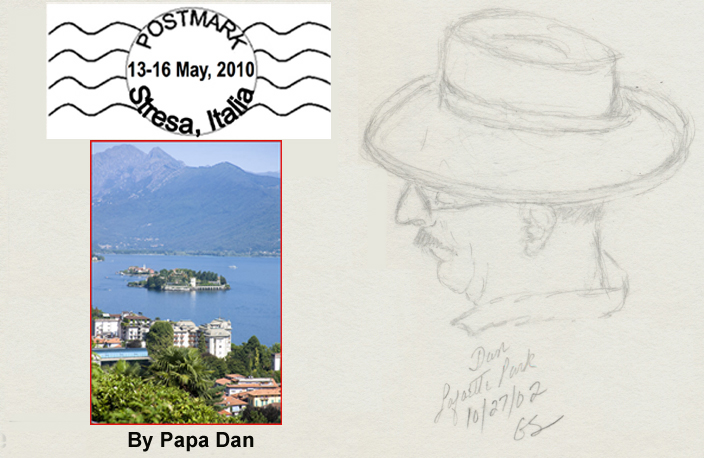 fourth visit to Italy begins here on the edge of Lago Maggiore, “the greater lake,” just west of our old friend, Lago di Como, in the Lombardia region of northern Italy. We’ve learned from experience the advantage of selecting the first place to stay after crossing the Atlantic to be a place to pause and get your bearings in a new country, without having any immediate time pressures and without a lot of stunning places that you ‘must see.’ In our case, we have already spend one night in New York before the longer flight from JFK airport to Malpensa Airport (MXP) in Milano. After our flight arrived nearly on time at 8:30 am, a driver took us by car from Malpensa right to the middle of this lakeside town. The next three days would be for exploring the islands in front of us; but today is for finding some red wine and good food, putting our feet up, and staring at the lake.
fourth visit to Italy begins here on the edge of Lago Maggiore, “the greater lake,” just west of our old friend, Lago di Como, in the Lombardia region of northern Italy. We’ve learned from experience the advantage of selecting the first place to stay after crossing the Atlantic to be a place to pause and get your bearings in a new country, without having any immediate time pressures and without a lot of stunning places that you ‘must see.’ In our case, we have already spend one night in New York before the longer flight from JFK airport to Malpensa Airport (MXP) in Milano. After our flight arrived nearly on time at 8:30 am, a driver took us by car from Malpensa right to the middle of this lakeside town. The next three days would be for exploring the islands in front of us; but today is for finding some red wine and good food, putting our feet up, and staring at the lake.
Crossing the Pond in ‘The Age of the Volcano’
SFO-JFK
So we’ve got this volcano closing airports all over Europe, JFK airport in NYC closed its most heavily used runway for repairs causing delays every day, and, oh yes, tornadoes have sprouted up all over the plains states. So we were having a hard tine expecting a smooth trip. For the past three days we’ve been tracking departure and arrival times, finding flight 16 from SFO to JFK has been running 2.5 hours late all week;. Flight 198, JFK to Malpensa airport in Milan, has been arriving 3.5 hours late this week except for Saturday, when it was canceled altogether. So, as the planner, my mental list of things that could go wrong, and contingency plans, was long.
However, for us, the taxi picked us up at home right on time, got to the terminal in an hour, boarded flight #16, and it departed on time! first lap: check. An hour before landing it was warm chocolate chip cookies and milk. Oh, and one more thing: we landed thirty minutes early.
So much for the hassles of air travel in the age of ‘The Volcano.’ A forty minute taxi ride brought us to Stresa, a beautiful touristy resort on Lago Maggiore.
Stresa and The Borromean Islands
Directly across the lake from our hotel are three islands — The Borromean Islands — that have been owned by the fabulously wealthy Borromeo banking family since Giberto Borromeo ‘The First’ bought the three islands during the first decade of the 16th century.
This purchase completed the Borromeo family’s control of the land all around Lago di Maggiore, known as “The Borromeo State” from the middle of the 15th century. The tremendous power and wealth of the Borromeo family — and its relatives, the Medici of Florence — culminated in the rise in the church of one of their sons, Carlo Borromeo, now know as St. Charles Borromeo. Charles was appointed archbishop of Milan shortly after the death of his uncle Gian Angelo de Medici (also known as Pope Pius IV) in 1565.
After a couple of decades establishing seminaries and defending the church against the Protestant Reformation, Carlo passed away, leaving his cousin Federico to carry on the family’s leadership in the church. Federico promptly mounted a 21st-century-style marketing campaign to get his cousin canonized, which would surely maximize Borromean power throughout Europe.
A contemperary wrote of the campaign: “the tomb of ‘the prince’ was offered as a center of devoted worship. Printed images and paintings of him, edifying tracts, biographies, rumors of miracles and apparitions, and the distribution of relics were not long on spreading his fame beyond the confines of the peninsula as well as recourse to his powers of intercession.” His campaign was successful — Charles was quickly declared a saint on November 1, 1610. As it turned out, the fame that went with the campaign didn’t do cousin Federico any harm either — along the way he got himself appointed to succeed his cousin as Archbishop of Milan and became a Cardinal in 1595, helping the family to consolidate influence and wealth from both sides of the altar. Meanwhile the rest of the family was building the magnificent Borromeo Palace that we visited yesterday — it occupies ALL of Isola Bella across the water from here (on the postcard above). I give them credit — they didn’t just build buildings — they surrounded themselves with well kept natural beauty, plants, art, and exotic animals from all over the world, still in evidence today, right down to the stunning white Chinese peacocks visible all over the island.
A more recent historical note about the palace — in 1935, BenIto Mussolini met in this palace with the leaders of England and France to sign a treaty intended to frighten the Germans sufficiently to deter them from starting World War II. The treaty, displayed on the wall in a room we visited, fizzled when Mussolini went home, allied himself with Hitler, and invaded Ethiopia.
So much for detterence.
Stresa was an excellent choice to get settled after flying across the Atlantic, a place to get over jet lag. It has a spectacular lakefull of historic islands that show off the tremendous opulence of the wealthy and influential families that built Europe on a Rennaisance foundation during the centuries from the 16th through the 19th. For that, we enjoyed our three days here immensely.
We met a French couple — from Alsace — at one of the mediocre restaurants in Stresa. It turns out that they too have returned often to both Varenna on Lago di Como and here at Stresa on Lago Maggiore. After sharing our experiences, the gentleman agreed with my summary: Stresa and Lago Maggiore are beautuful; but Varenna and Lago di Como are magic.
So today the train Is taking us back to Varenna where we will stay at our favorite ‘home’ — Albergo Milano — for seven days. Perhaps we’ll see you there.
National Poetry Month Ends: Happy Birthday, Will Shakespeare!
 In honor of the birthday (April 23) of the world’s greatest poet and playwright, we add to our month-long poetry reading what some consider the greatest pair of love poems in the language.
In honor of the birthday (April 23) of the world’s greatest poet and playwright, we add to our month-long poetry reading what some consider the greatest pair of love poems in the language.
Romeo speaks first as he looks up at Juliet’s balcony and catches a glimpse of her as she laments the unfairness of falling in love with a boy whose family is the sworn enemy of her family. Meanwhile, he thinks about how nice it would be to touch her cheek (but he says it nicely, for a guy . . . ).
Then, she speaks some widely misunderstood lines, wondering WHY (remember, “wherefore” = “why”) WHY he is Romeo? WHY he must be a Montague? She also wonders why he wouldn’t be willing to solve the problem by giving up his name, since she is willing to give up hers (a legitimate question, eh?).
ROMEO AND JULIET
Act 2, Scene 2
ROMEO
But, soft! what light through yonder window breaks?
It is the east, and Juliet is the sun.
Arise, fair sun, and kill the envious moon,
Who is already sick and pale with grief,
That thou her maid art far more fair than she:
Be not her maid, since she is envious;
Her vestal livery is but sick and green
And none but fools do wear it; cast it off.
It is my lady, O, it is my love!
O, that she knew she were!
She speaks yet she says nothing: what of that?
Her eye discourses; I will answer it.
I am too bold, ’tis not to me she speaks:
Two of the fairest stars in all the heaven,
Having some business, do entreat her eyes
To twinkle in their spheres till they return.
What if her eyes were there, they in her head?
The brightness of her cheek would shame those stars,
As daylight doth a lamp; her eyes in heaven
Would through the airy region stream so bright
That birds would sing and think it were not night.
See, how she leans her cheek upon her hand!
O, that I were a glove upon that hand,
That I might touch that cheek!
JULIET
Ay me!
ROMEO
She speaks:
O, speak again, bright angel! for thou art
As glorious to this night, being o’er my head
As is a winged messenger of heaven
Unto the white-upturned wondering eyes
Of mortals that fall back to gaze on him
When he bestrides the lazy-pacing clouds
And sails upon the bosom of the air.
JULIET
O Romeo, Romeo! wherefore art thou Romeo?
Deny thy father and refuse thy name
Or, if thou wilt not, be but sworn my love,
And I’ll no longer be a Capulet.
ROMEO
[Aside] Shall I hear more, or shall I speak at this?
JULIET
‘Tis but thy name that is my enemy;
Thou art thyself, though not a Montague.
What’s Montague? it is nor hand, nor foot,
Nor arm, nor face, nor any other part
Belonging to a man. O, be some other name!
What’s in a name? that which we call a rose
By any other name would smell as sweet;
So Romeo would, were he not Romeo call’d,
Retain that dear perfection which he owes
Without that title. Romeo, doff thy name,
And for that name which is no part of thee
Take all myself.
=================================
Preview of Coming Attractions
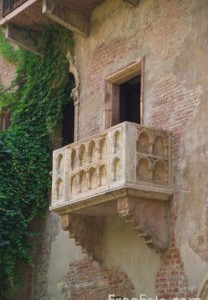 In June, Gretta and I plan to drop by and visit this balcony in Verona, which the locals claim is THE balcony in this famous scene. William Shakespeare, son of John Shakespeare, never visited Verona; but his characters do have some pretty impressive Veronese roots. In 1597, when Shakespeare wrote Romeo & Juliet, Luigi Da Porta’s 1530 story of Romeo Montecchi and Giulietta Cappelletti (names taken from Dante’s Purgatorio) was fairly well known to many of Shakespeare’s contemporaries, as were other published versions by Bandello (1554) and The Tragicall Historye of Romeus and Juliett (1562) attributed to Arthur Brooke. Events in the play have caused some to make connections to real characters and events (including an earthquake in Italy in 1570 and a duel in 1581 with familiar details). All of this has led to conspiracy theories questioning Shakespeare’s authorship.
In June, Gretta and I plan to drop by and visit this balcony in Verona, which the locals claim is THE balcony in this famous scene. William Shakespeare, son of John Shakespeare, never visited Verona; but his characters do have some pretty impressive Veronese roots. In 1597, when Shakespeare wrote Romeo & Juliet, Luigi Da Porta’s 1530 story of Romeo Montecchi and Giulietta Cappelletti (names taken from Dante’s Purgatorio) was fairly well known to many of Shakespeare’s contemporaries, as were other published versions by Bandello (1554) and The Tragicall Historye of Romeus and Juliett (1562) attributed to Arthur Brooke. Events in the play have caused some to make connections to real characters and events (including an earthquake in Italy in 1570 and a duel in 1581 with familiar details). All of this has led to conspiracy theories questioning Shakespeare’s authorship.
I, of course, am convinced that Shakespeare wrote this play (and others set in Italy) from stories told to him by travelers (perhaps Christopher Marlowe) who had visited Verona. I have been, so far, unconvinced that Christopher Marlowe escaped from a deadly scandal by faking his own death and emerging in London as William Shakespeare and suddenly becoming the greatest poet and playwright of all time. However, I am about the read James Shapiro’s new book Contested Will: Who Wrote Shakespeare?, which focuses on this subject; so, I’ll get back to you on that . . . Perhaps standing beneath “Juliet’s” balcony, the truth will emerge.
=================
One more
This is my last post in honor of National Poetry Month. A new reader to this blog Shelley Clements, has sent us a few of hers and and I offer one of them below. She sent more, but, heck, perhaps appearing on the same page with two of Shakespeare’s will be comforting. I like this one.
Code Breaker
by Shelley Clements
i read and
re read
your poetry
i try to lure your words to me
coax them out softly
whisper them aloud
as if they were my own
i patch the inadequacies
with my own imaginings
yours are too spare
too lacking in enthusiasms:
a neglected wheel barrow
frost flecked and rust ready
keeping company with chalky hens
depends so much upon
finding resonance in
each word each line
of your “masterful” poem
i read and
re read
your poetry
i try to decrypt your words
as if they were precious glyphs
divine their meaning as if they were smoke
but i lack the language of the Navajo
==========
NOW, it is time to start thinking about Italy and Austria.
April Is Still National Poetry Month — Part Two
Four Poems From ConVivio’s First Guest Poet
 Dorty Nowak is a writer and artist living in Paris and Berkeley who writes frequently about the challenges and delights of multi-cultural living. A former educator and insurance executive, she helped found the Oakland School for the Arts. She is currently developing a collaborative project, ”Where Do I Belong,” involving artists and poets from Europe, Australia, and the U.S.
Dorty Nowak is a writer and artist living in Paris and Berkeley who writes frequently about the challenges and delights of multi-cultural living. A former educator and insurance executive, she helped found the Oakland School for the Arts. She is currently developing a collaborative project, ”Where Do I Belong,” involving artists and poets from Europe, Australia, and the U.S.
In response to our recent ‘National Poetry Month’ post, Dorty offers a couple of her favorites by Richard Wilbur and Wallace Stevens; and, she says, “because I’ll never pass up a chance for extra credit” she gives us two of her own creations. To introduce her own poems, “Windsurfer“ and “Haiku“ (below), she writes: “Recently I have been experimenting with various poetic forms. I particularly like haiku because the form demands a deceptive simplicity. I wrote “Windsurfers” while sitting on a beach in Mexico last year watching my friends windsurf. I was captivated by their skill and beauty.” — Dorty.
Since ‘National Poetry Month’ is . . . well . . . a month long, she hopes others will take this opportunity to contribute some of their favorites.
Some of Dorty’s recent contributions to the world of ideas can also be found at the “Your Life Is A Trip” blog at: http://www.yourlifeisatrip.com/home/author/dortynowak
◊◊◊◊◊◊◊◊◊◊◊◊◊◊◊◊◊◊◊◊
Love Calls Us to the Things of This World
by Richard Wilbur
The eyes open to a cry of pulleys,
And spirited from sleep, the astounded soul
Hangs for a moment bodiless and simple
As false dawn.
Outside the open window
The morning air is all awash with angels.
Some are in bed-sheets, some are in blouses,
Some are in smocks: but truly there they are.
Now they are rising together in calm swells
Of halcyon feeling, filling whatever they wear
With the deep joy of their impersonal breathing;
Now they are flying in place, conveying
The terrible speed of their omnipresence, moving
And staying like white water; and now of a sudden
They swoon down into so rapt a quiet
That nobody seems to be there.
The soul shrinks
From all that is about to remember,
From the punctual rape of every blessed day,
And cries,
“Oh, let there be nothing on earth but laundry,
Nothing but rosy hands in the rising steam
And clear dances done in the sight of heaven.”
Yet, as the sun acknowledges
With a warm look the world’s hunks and colors,
The soul descends once more in bitter love
To accept the waking body, saying now
In a changed voice as the man yawns and rises,
“Bring them down from their ruddy gallows;
Let there be clean linen for the backs of thieves;
Let lovers go fresh and sweet to be undone,
And the heaviest nuns walk in a pure floating
Of dark habits,
keeping their difficult balance.”
The Snow Man
by Wallace Stevens
One must have a mind of winter
To regard the frost and the boughs
Of the pine-trees crusted with snow;
And have been cold a long time
To behold the junipers shagged with ice,
The spruces rough in the distant glitter
Of the January sun; and not to think
Of any misery in the sound of the wind,
In the sound of a few leaves,
Which is the sound of the land
Full of the same wind
That is blowing in the same bare place
For the listener, who listens in the snow,
And, nothing himself, beholds
Nothing that is not there and the nothing that is.
Windsurfers
by Dorty Nowak
Oil slicked bodies stretch and strain,
Hold their wings against the pull of wind.
Born from the chrysalis of board and sail,
A host of dragonflies.
Sails skim the surface of the sea,
Their colors flashing in the sun.
They swoop and flit to quilt the waves.
They seem, if only for a moment, to fly.
What grace to break the human bond,
To bend such power to their ways,
Calling on gods of wind and wave,
To transform them as they play.
Haiku
by Dorty Nowak
Irrefutable
your logic sticks like a bone
in just the wrong place
◊◊◊◊◊◊◊◊◊◊◊◊◊◊◊◊◊◊◊◊
As always, your comments are always welcome and we would still like to see more of your favorite poems in this space. There are still three full weeks left in National Poetry Month!
April Is National Poetry Month
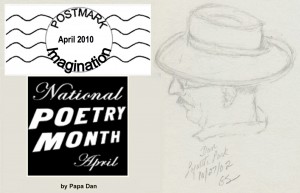 Let’s try a few
Let’s try a few
In honor of National Poetry Month, which begins next Thursday, I have assembled here a dozen of my favorites. In our culture, poetry is the neglected art form — and that’s why we need a ‘National Poetry Month.’ As you can see from my selections, “poetry” can take many forms — from the very long to the very short, from rhyming couplets to paragraphs of ‘natural’ speech, from bold optimism to its opposite. Poetry was defined by William Wordsworth as “the spontaneous overflow of powerful feelings . . . emotion recollected in tranquility.” It can be presented in many styles, from the simplest sincerity to the most cutting sarcasm; and it can address a wide range of themes. My little collection is surely not exhaustive and not even likely to yield universal agreement that it is all poetry. Not a “top-dozen” list, it is a sample of some eloquent uses of vivid, compact language, some creating distinctive characters, some expressing assertions of belief, some old friends to be re-visited, some new, all attempting to bring ideas to life with words that evoke rich images. Most are best read aloud, some with music; all are best when given a bit of time to have their way. Many of these contain a line or two — teasers, if you will — that matter very much to me — for example:
• “Try to see it, not with your eyes, for they are wise . . . ”
• “Sweet time unafflicted”
• “And that has made all the difference”
• “At a place that chose them”
• “You know how it is with an April day . . .”
• “My object in living is . . . ”
• “And smale fowles maken melodye”
• “(a leaf falls)”
• “Waiting to be named . . . THE GREAT HAJI”
• “In another world, someone over there is . . . ”
• “When you have prayed for victory, you have prayed for many unmentioned results . . . ”
• “Yes, we can ”
• “We ain’t what we was.”
Your comments about any of the following ‘poems’ are welcome. If you are interested, please share with us one or more of YOUR favorite poems. If you write one of your own, you get ‘extra credit!’
===========================
A Perfect Time To Be In Love
By Tom Jones
You wonder how these things begin.
Well, this begins with a glen.
It begins with a season, which,
For want of a better word,
We might as well call September.
It begins with a forest,
Where the woodchucks woo,
And leaves wax green,
And vines entwine like lovers.
Try to see it, not with your eyes
for they are wise;
But see it with your ears:
The cool green breathing of the leaves;
And hear it with the inside of your hand:
The soundless sound of shadows flicking light.
Celebrate sensation!
Recall that secret place,
You’ve been there, you remember,
That special place where once,
Just once, in your crowded sunlit lifetime
You hid away in shadows from the tyranny of time.
That spot beside the clover,
Where someone’s hand held your hand,
Where love was sweeter than the berries
Or the honey
Or the stinging taste of mint.
It is September, before a rain fall
A perfect time to be in love . . .”
===========================
ABC
by Robert Pinsky
Any Body Can Die, Evidently. Few
Go Happily, Irradiating Joy,
Knowledge, Love. Many
Need Oblivion, Painkillers,
Quickest Respite.
Sweet Time Unafflicted,
Various World:
X=Your Zenith.
===========================
The Road Not Taken
by Robert Frost
Two roads diverged in a yellow wood,
And sorry I could not travel both
And be one traveler; long I stood
And looked down one as far as I could
To where it bent in the undergrowth;
Then took the other, as just as fair,
And having perhaps the better claim,
Because it was grassy and wanted wear;
Though as for that the passing there
Had worn them really about the same.
And both that morning equally lay
In leaves no step had trodden black.
Oh, I kept the first for another day!
Yet knowing how way leads on to way,
I doubted if I should ever come back.
I shall be telling this with a sigh
Somewhere ages and ages hence:
Two roads diverged in a wood,
and I— I took the one less traveled by,
And that has made all the difference.
===========================
Two to One
by D.R. Sapone
(for the occasion of Ben and Cary’s wedding)
Two ‑
Shall grow from roots planted
far away across the world;
Shall arrive apart,
at a place that chose them;
Shall discover the beauty of the world
through the eyes of the other;
Shall decide to be known,
wherever the world takes them, as
‑ One
===========================
Two Tramps in Mud Time
By Robert Frost
Out of the mud two strangers came
And caught me splitting wood in the yard,
And one of them put me off my aim
By hailing cheerily “Hit them hard!”
I knew pretty well why he had dropped behind
And let the other go on a way.
I knew pretty well what he had in mind:
He wanted to take my job for pay.
Good blocks of oak it was I split,
As large around as the chopping block;
And every piece I squarely hit
Fell splinterless as a cloven rock.
The blows that a life of self-control
Spares to strike for the common good,
That day, giving loose to my soul,
I spent on the unimportant wood.
The sun was warm but the wind was chill.
You know how it is with an April day
When the sun is out and the wind is still,
You’re one month on in the middle of May.
But if you so much as dare to speak,
A cloud comes over the sunlit arch,
A wind comes off a frozen peak,
And you’re two months back in the middle of March.
A bluebird comes tenderly up to alight
And turns to the wind to unruffle a plume,
His song so pitched as not to excite
A single flower as yet to bloom.
It is snowing a flake; and he half knew
Winter was only playing possum.
Except in color he isn’t blue,
But he wouldn’t advise a thing to blossom.
The water for which we may have to look
In summertime with a witching wand,
In every wheelrut’s now a brook,
In every print of a hoof a pond.
Be glad of water, but don’t forget
The lurking frost in the earth beneath
That will steal forth after the sun is set
And show on the water its crystal teeth.
The time when most I loved my task
These two must make me love it more
By coming with what they came to ask.
You’d think I never had felt before
The weight of an ax-head poised aloft,
The grip of earth on outspread feet,
The life of muscles rocking soft
And smooth and moist in vernal heat.
Out of the wood two hulking tramps
(From sleeping God knows where last night,
But not long since in the lumber camps).
They thought all chopping was theirs of right.
Men of the woods and lumberjacks,
They judged me by their appropriate tool.
Except as a fellow handled an ax
They had no way of knowing a fool.
Nothing on either side was said.
They knew they had but to stay their stay
And all their logic would fill my head:
As that I had no right to play
With what was another man’s work for gain.
My right might be love but theirs was need.
And where the two exist in twain
Theirs was the better right–agreed.
But yield who will to their separation,
My object in living is to unite
My avocation and my vocation
As my two eyes make one in sight.
Only where love and need are one,
And the work is play for mortal stakes,
Is the deed ever really done
For Heaven and the future’s sakes.
===========================
“Aprille” From the General Prologue to Canterbury Tales
by Geoffrey Chaucer
[Its famous first ten lines . . . each line followed
by a pronunciation guide to the original 14th-century
‘Middle English’ — Click here and again on the sound bar to listen to it]
Whan that Aprille with his shoores soote
[Wan thot A’prill with his sure-es so-tuh]
The drought of March hath perced to the roote
[The drewgt of March hath pear-said to the row-tuh]
And bathed every vein in swich liquor
[And ba-thed every vane in sweech lee-coor]
Of which vertu engendred is the flour
[of wheech ver-too en-jen-dred is the flu-er]
When Zephyrus eek with his sweete breeth
[When Zeph-er-us ache with his sway-tuh breath]
Inspired hath in every holt and heeth
[In-spear-ed hath in every holt and heth]
The tendre croppes and the yonge sun
[The tawn-dray crop-pays and the young-gay soan]
Hath in the ram his halve cours yronne
[Hath in the rahm his hall-vey coors e-rown]
And smale fowles maken melodye
[And smal-ay foe-lays mock-en mel-oh-dee-uh]
That slepen all the night with open eye
[That slep-en all the neekdt with open ee-ah]
===========================
l(ale
============================
(A Footnote) From Lake Wobegon Days
by Garrison Keillor
To his parents: ‘Things you taught me’
For fear of what it might do to me, you never paid me a compliment,
and when other people did, you beat it away from me with a stick.
“He certainly is looking nice and grown up.”
You would reply: “He’d look a lot nicer if he did something about his skin.”
“That’s wonderful that he got a job.”
“Yeah, well, we’ll see how long it lasts.”
You trained me so well, I now perform this service for myself.
I deflect every kind word directed to me, and my denials
are much more extravagant than the praise.
“Good speech.”
“Oh it was way too long, I didn’t know what I was talking about,
I was just blathering on and on, I was glad when it was over.”
I do this under the impression that it is humility, a becoming quality in a person.
Actually, I am starved for a good word, but after the long drought of my youth, no word is quite good enough.
[Voice rising] “Good” isn’t enough. Under this thin veneer of modesty lies a MONSTER of greed.
I drive away faint praise, beating my little chest, waiting to be named
[Shouting now] SUN-GOD, KING OF AMERICA, IDOL OF MILLIONS, BRINGER OF FIRE,
THE GREAT HAJI, THUND-DAR THE BOY GIANT.
I don’t want to say, “Thanks, glad you liked it.” I want to say:
“RISE MY PEOPLE. REMOVE YOUR FACES FROM THE CARPET STAND, AND LOOK ME IN THE FACE!”
===========================
Golden Earth Girl
by Paul McCartney
Golden earth girl, female animal,
sings to the wind, resting at sunset,
in a mossy nest, sensing moonlight in the air,
moonlight in the air.
Good clear water, friend of wilderness
sees in the pool her own reflection.
In another world
someone over there is counting
fish in a sunbeam,
in eggshell seas.
fish in a sunbeam,
eggshell finish.
Natures lover climbs the primrose hill,
smiles at the sky, watching the sunset,
from a mossy nest.
As she falls asleep she’s counting
Fish in a sunbeam,
in eggshell seas.
fish in a sunbeam,
eggshell finish.
===========================
The War Prayer
by Mark Twain
It was a time of great and exalting excitement. The country was up in arms, the war was on, in every breast burned the holy fire of patriotism; the drums were beating, the bands playing, the toy pistols popping, the bunched fire-crackers hissing and spluttering; on every hand and far down the receding and fading spread of roofs and balconies, a fluttering wilderness of flags flashed in the sun; daily the young volunteers marched down the wide avenue gay and fine in their new uniforms, the proud fathers and mothers and sisters and sweethearts cheering them with voices choked with happy emotion as they swung by; nightly the packed mass meetings listened, panting, to patriot oratory which stirred the deepest deeps of their hearts and which they interrupted at briefest intervals with cyclones of applause, the tears running down their cheeks the while; in the churches the pastors preached devotion to flag and country and invoked the God of Battles, beseeching His aid in our good cause in outpouring of fervid eloquence which moved every listener.
It was indeed a glad and gracious time, and the half dozen rash spirits that ventured to disapprove of the war and cast a doubt upon its righteousness straightway got such a stern and angry warning that for their personal safety’s sake they quickly shrank out of sight and offended no more in that way.
Sunday morning came–next day the battalions would leave for the front; the church was filled; the volunteers were there, their young faces alight with martial dreams–visions of the stern advance, the gathering momentum, the rushing charge, the flashing sabers, the flight of the foe, the tumult, the enveloping smoke, the fierce pursuit, the surrender!
Then home from the war, bronzed heroes, welcomed, adored, submerged in golden seas of glory! With the volunteers sat their dear ones, proud, happy, and envied by the neighbors and friends who had no sons and brothers to send forth to the field of honor, there to win for the flag, or, falling, to die the noblest of noble deaths. The service proceeded; a war chapter from the Old Testament was read; the first prayer was said; it was followed by an organ burst that shook the building, and with one impulse the house rose, with glowing eyes and beating hearts, and poured out that tremendous invocation:
“God the all-terrible! Thou who ordainest,
Thunder thy clarion and lightning thy sword.”
Then came the “long” prayer. None could remember the like of it for passionate pleading and moving and beautiful language. The burden of its supplication was that an ever-merciful and begnignant Father of us all would watch over our noble young soldiers, and aid, comfort and encourage them in their patriotic work; bless them; shield them in the day of battle and the hour of peril, bear them in His mighty hand, make them strong and confident, invincible in the bloody onset; help them to crush the foe, grant to them and to their flag and country imperishable honor and glory–
An aged stranger entered and moved with slow and noiseless step up the main aisle, his eyes fixed upon the minister, his long body clothed in a robe that reached to his feet, his head bare, his white hair descending in a frothy cataract to his shoulders, his seamy face unnaturally pale, pale even to ghastliness. With all eyes following him and wondering, he made his silent way; without pausing he ascended to the preacher’s side and stood there waiting. With shut lids the preacher, unconscious of his presence, continued his moving prayer, and at last finished it with the words uttered in fervent appeal, “Bless our arms, grant us the victory, O Lord our God, Father and Protector of our land and flag!”
The stranger touched his arm, motioned him to step aside–which the startled minister did–and took his place. During some moments he surveyed the spellbound audience with solemn eyes, in which burned an uncanny light; then in a deep voice he said:
“I come from the Throne — bearing a message from Almighty God.” The words smote the house with a shock; if the stranger perceived it he gave no attention. “He has heard the prayer of His servant your shepherd, and will grant it if such be your desire after I, His messenger, shall have explained to you its import – -that is to say, its full import. For it is like unto many of the prayers of men, in that it asks for more than he who utters it is aware of–unless he pause and think. God’s servant and yours has prayed his prayer. Has he paused and taken thought? Is it one prayer? No, it is two–one uttered, the other not. Both have reached the ear of Him who heareth all supplications, the spoken and the unspoken. Ponder this — keep it in mind. If you would beseech a blessing upon yourself, beware! Lest without intent you invoke a curse upon a neighbor at the same time. If you pray for the blessing of rain upon your crop which needs it, by that act you are possibly praying for a curse upon some neighbor’s crop which may not need rain and can be injured by it.
“You have heard your servant’s prayer–the uttered part of it. I am commissioned of God to put into words the other part of it — that part which the pastor — and also in your hearts–fervently prayed silently. And ignorantly and unthinkingly? God grant that it was so! You have heard those words ‘Grant us the victory, O Lord our God.’ That is sufficient. The whole of the uttered prayer is compact into those pregnant words. Elaborations were not necessary. When you have prayed for victory, you have prayed for many unmentioned results which follow victory — must follow it, cannot help but follow it. Upon the listening spirit of God the Father fell also the unspoken part of the prayer. He commandeth me to put it into words. Listen!
“O Lord our Father, our young patriots, idols of our hearts, go forth to battle — be Thou near them! With them, in spirit, we also go forth from the sweet peace of our beloved firesides to smite the foe. O Lord our God, help us to tear their soldiers to bloody shreds with our shells; help us to cover their smiling fields with the pale forms of the patriot dead; help us to drown the thunder of their guns with the shrieks of their wounded, writhing in pain; help us to lay waste their humble homes with a hurricane of fire; help us to wring the hearts of their offending widows with unavailing grief; help us to turn them out roofless with their little children to wander unfriended the wastes of their desolated land in rags and hunger and thirst, sports of the sun flames of summer and the icy winds of winter, broken in spirit, worn with travail, imploring Thee for the refuge of the grave and denied it —
“For our sakes who adore thee, Lord, blast their hopes, blight their lives, protract their bitter pilgrimage, make heavy their steps, water their way with their tears, stain the white snow with the blood of their wounded feet!
“We ask it, in the spirit of love, of Him who is the Source of Love, and Who is the Ever-Faithful Refuge and Friends of all who are sore beset and seeking His aid with humble and contrite hearts. Amen.”
(The old man paused). “Ye have prayed it; if you still desire it, speak! The messenger of the Most High awaits.”
* * * * *
It was believed afterward that the man was a lunatic, because there was no sense in what he said.
— Mark Twain
===========================
Yes, We Can
By Barack Obama, others
It was a creed written into the founding documents that declared the destiny of a nation:
Yes, we can.
It was whispered by slaves and abolitionists
as they blazed a trail towards freedom through the darkest of nights:
Yes, we can.
It was sung by immigrants as they struck out from distant shores
and pioneers who pushed westward against an unforgiving wilderness:
Yes, we can.
It was the call of workers who organized,
women who reached for the ballot,
a president who chose the moon as our new frontier,
and a king who took us to the mountaintop
and pointed the way to the promised land:
Yes, we can, to justice and equality;
Yes, we can, to opportunity and prosperity;
Yes, we can heal this nation;
Yes, we can repair this world.
Yes, we can.
===========================
Prayer of a Former Slave
Lord, we ain’t what we want to be;
We ain’t what we ought to be;
We ain’t what we gonna be;
But thank God almighty, we ain’t what we was.
===========================
Mister Kitty is the boss, and he knows it
MK Issues Mixed Approvals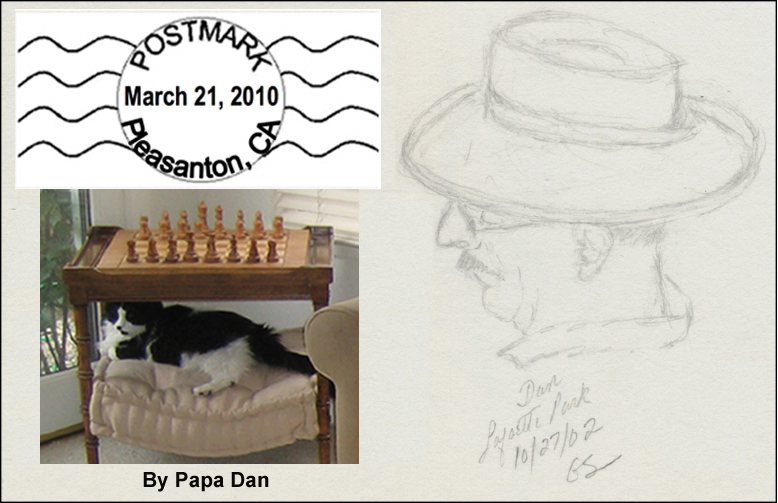
He owns the place. We are responsible for his comfort and well-being; and he is in control of . . . well . . . everything else, including, evidently, the turning of the seasons and this nation’s most important national decisions.
Mister Kitty knows that the entire reason we earn a living and maintain a household is to keep a roof over his head, keep his food and water bowls filled, maintain a clean kitty-litter box, provide a multitude of places for him to curl up and rest when he needs to, and to brush his fur when he wants it brushed. He also knows that, in order for him to feel fulfilled and complete as a Cat, everyone around him must be busy doing things —approved things, that is. The activity around him makes him feel the sense of accomplishment and superiority that he knows is his birthright.
Example — this month we have initiated three projects in parallel, hoping to elicit his approval and supervisorial support:
Project Number One: a trench for a gas line had to be dug from the gas meter in the front yard, under the walkway and gate, all the way around the side of the house, under the bricks to the back of the house directly behind the fireplace. As a result, stepping stones, a rock pathway, and a piece of sidewalk had to be dug up, moved, and set temporarily aside. Then, once the trench was dug, the gas line was laid in the trench to be connected to the envisioned gas fireplace. All of this met with Mister Kitty’s approval because it took place outside of the house where none of his resting spots were disturbed. He liked the fact that people were working hard just outside his field of vision where he could hear them grunt and cuss with exertion and frustration. He liked that because it appealed to his sense of management and authority that such an activity was conducted in a location he had approved (i.e., elsewhere) and physical burdens were placed on the right individuals (i.e., not him). He was able to select a place to rest from which he could supervise without having his routine disrupted.
Project Number Two: After the gas and electrical connections were completed and inspected, catalogs and brochures were studied, and a gas-burning fireplace insert was selected at a local store. This met with mixed approvals. The research was acceptable, consisting as it did of page-turning, measurement, and conversation — approved activities. MK also seems to support the environmental aspect of the project — eliminating the negative air-quality impacts of burning wood in the fireplace.
However, bringing the gas and electrical supply lines into the fireplace was another matter entirely. This aspect of the project required noisy power equipment to be utilized inside of his house. This did not meet with Messr. Kitté’s approval, evident by his disappearance under the bed for the duration of the work. Several hours after the noise stopped and the intruders had been dispatched, Mister Kitty made known his disapproval with the familiar yowls that generally accompany such objection. Other inhabitants of the house waited in fearful anticipation for possible retributive consequences that often consist of multiple, reverse post-digestive deposits made in the most visible and well-traveled portions of the white carpet.
Project Number Three: Plans were made to replace the white carpet with red oak hardwood floors on the bottom story of the house. Estimates were solicited, samples were compared, measurements were taken, and a specific product selected to maximize the efficiency of the work yet to come and minimize the effect on his schedule. Mister Kitty is generally supportive of the quiet, non-violent activity and expressed no noticeable disapproval, sitting at a safe distance and watching with interest. There is much concern, however, throughout the household that, when Project Number Three moves from the planning to the implementation phase, the expected levels of cutting, removal, banging, clatter, and general riotous behavior expected from the hardwood floor installers will yield extreme consequences resulting from strong disapproval. Bedspreads, couches, and other stainable surfaces elsewhere in the house are considered to be in serious jeopardy.
Suspecting as we do that His Eminent Kittiness may have unphyisical powers at his disposal, we may have already begun to experience a preliminary act of retribution for, at least, the offensive aspects of Project Number Two. We are all but convinced that MK is responsible for the fact that, now that the fireplace is fully installed and ready for operation, the past three days have been the three warmest days of this year, making the use of the fireplace unreasonable. So, today, Mister Kitty is sitting on his throne (pictured at the top of this essay), with a superior expression on his face, satisfied that he is responsible for the fact that we sit staring at the darkened fireplace, with doors and windows of the house open, trying to mitigate the effects of such warmth. The fact that today is the first official day of Spring is surely a mere coincidence.
By the way, after a day of sitting in front of C-SPAN on television, watching the workings of the House of Representatives, Mister Kitty — a Democrat — has expressed his approval of the passage of the Health Care Reform legislation as the first step toward restoring justice to the availability of health care in this nation. MK feels a close affinity with that other “MK,” (Dr. Martin King) who said many times that equal access to affordable and quality health care is an important attribute of a society on which the justice of that society must be properly judged. If it can be made true that any boy or girl can be born in this country and live in a family whose access to health care is assured and does not put their economic survival at risk in the event of an illness or accident, Mister Kitty can sit on his cushion with pride in his country and optimism for its future. Recognition that today’s events represent only one step toward that goal — an essential step, but only one of many — is an example of his inherent wisdom.
Words Are Dropping Out of the Language like . . .
 It doesn’t take a literary scholar to notice that the English language has changed a lot over its lifetime. The ‘Old English’ of the 11th century is quite unrecognizable to us moderns. It’s hard to believe it’s ‘English.’ (Click to listen to the first line of the Old English epic poem Beowulf).
It doesn’t take a literary scholar to notice that the English language has changed a lot over its lifetime. The ‘Old English’ of the 11th century is quite unrecognizable to us moderns. It’s hard to believe it’s ‘English.’ (Click to listen to the first line of the Old English epic poem Beowulf).
By the time the language evolved to ‘Middle English’ through the 12th-15th centuries, it started to look and sound a bit more familiar to us; but it still had a decidedly foreign sound to our modern ears. (Click for a little Chaucer.) Eventually, the so-called ‘Chancery Standard’ of the 1470s led the way to the Elizabethan English we recognize in Shakespeare. (Romeo & Juliet at the balcony)
We tend to think of the 400 years from Shakespeare to John Lennon as a long stable period of standardization. However, as I near the end of my sixth decade speaking this language, I am noticing that many words and phrases that I grew up with have been dropping out of the language. Some have been replaced with new ones created with the help of the scientific and cultural innovation that has exploded during my lifetime. Others have just dropped off the wagon to be crushed under the wheels of 21st-century multimedia (ouch!). These changes in our language certainly demonstrate the forces that have shaped our language through its long and varied history. A few examples of verbal the casualties from my youth serve to illustrate —
Since our fascination with automobiles dominated popular American culture in the 1950s, the language reflected that reality. How many of you remember ‘fender skirts?’ These popular add-ons were a luxury item for several automobile models.
All of my dad’s cars had ‘curb feelers’ in the 1950s and 60s, and the sound they made scraping against the curb was the sound we all associated with the arrival of a car in front of our house. A familiar status symbol I associated with ‘cool’ was the ‘steering knob.’ Some called them ‘Necker’s knobs’ because they allowed a young man to steer with one hand while ‘necking’ (when’s the last time you heard that word) with the girl beside him. Fortunately, ‘steering knobs’ went out of favor for reasons illustrated by their more pejorative name: ‘suicide knobs.’ So, these words left the language as automobile fashion and technology left these devices behind.
When are we going to stop referring to ’emergency brakes’ — perhaps when more of us realize that they were of little use in a real emergency and, as ‘parking brakes,’ their value is actually to prevent emergencies. ‘Continental Kits’ were a symbol of faux luxury hanging off the back of a car that was otherwise not a Lincoln Continental.
How many of you remember that headlight high-beams were activated with ‘dimmer switches’ located on the floor to the left of the clutch? (And how many of us are beginning to forget what a clutch does?) Did you have a car with a ‘spoiler’ in the 60s? How about glass packs? Again, these words are either gone or on their way out.
Our language has off-loaded a number of other words beyond the language of automobiles. When was ‘supper’ replaced by ‘dinner’ — perhaps it was about the time the verb ‘to sup’ was replaced with the verb ‘to dine?’ Do you remember when a ‘store-bought’ dress or ‘store-bought’ cookies were considered luxuries back when so many items of food and clothing were manufactured by moms? Today, nobody calls attention to the fact that anything is ‘store-bought.’ And I still remember how proud my parents were when they covered up their hardwood floors with new ‘wall-to-wall carpets,’ which were a status symbol in the 1950s. I find that especially fascinating as Gretta and I prepare to have our own carpets removed next week and replaced with hardwood floors. As we discuss that plan, I haven’t heard anyone use the term ‘wall-to-wall.’
I had a ‘percolator’ in my dormitory room in 1968. When was that last time you heard that word?  By the time I graduated in 1972, I had all but heard the last of it. (More trivia: does anyone remember the name of the spokesman who starred in the Mr. Coffee commercials that ended the reign of percolators and introduced the term ‘coffee maker’ to the language?) Similarly, my Dad had a ‘Hi-Fi’ that played all of his records when I was a kid. By the time I needed one of my own, the word ‘stereo’ had taken over. While the word ‘turntable’ seems to be surviving (at least as long as vinyl records remain collectibles), but how many people in our more recent generations remember the technological origin of the word ‘groovy’ — even if they still hear their elders use that silly word? Do you still use the word ‘album’ to refer to a recording with more than two songs on it? Or do you use the word ‘LP?’ My Dad used to call them ’33s’ and ’78s.’ (I still have some of my old ’45s.’) There is extra credit for anyone who can tell us what an EP was. I bought one produced by the Beatles in 1964.
By the time I graduated in 1972, I had all but heard the last of it. (More trivia: does anyone remember the name of the spokesman who starred in the Mr. Coffee commercials that ended the reign of percolators and introduced the term ‘coffee maker’ to the language?) Similarly, my Dad had a ‘Hi-Fi’ that played all of his records when I was a kid. By the time I needed one of my own, the word ‘stereo’ had taken over. While the word ‘turntable’ seems to be surviving (at least as long as vinyl records remain collectibles), but how many people in our more recent generations remember the technological origin of the word ‘groovy’ — even if they still hear their elders use that silly word? Do you still use the word ‘album’ to refer to a recording with more than two songs on it? Or do you use the word ‘LP?’ My Dad used to call them ’33s’ and ’78s.’ (I still have some of my old ’45s.’) There is extra credit for anyone who can tell us what an EP was. I bought one produced by the Beatles in 1964.
Did anyone notice when we stopped using the word ‘brassiere’ and the word ‘bra’ became the norm? Not long before that, I remember hearing my parents refer to underwear as ‘unmentionables’ in mixed company. ‘Pregnant’ was considered too graphic or clinical — certainly for TV. Do you remember when the expression “in a family way’ was the proper euphemism? When was the last time you heard that expression?
Can you think of other words that have begun to drop out of our language? Are there sports terms that have disappeared from the lexicon? (‘Basket catch?’, ‘pine tar?’) Have we lost any movie vocabulary? (Do people still go to see ‘flicks?” Have you heard the word ‘Celluloid’ in the last decade or so?) Words associated with politics? Books? Television? (Do they still have ‘test patterns’ very late at night?)
Here’s a ‘lost-word’ trivia question: Can anyone explain the clever play on words — including a word we don’t use anymore — that John Lennon was using in the title of a book of nonsense stories and drawings he published in 1965 called A Spaniard in the Works? No fair looking it up [oh, go ahead, you won’t get it otherwise].
What other verbal casualties can you think of?
Ain’t Goin’ Down Easy
Of course, the rules of usage and grammar are the hardest to change. For some reason, people get offended when other people begin neglecting or bending the rules of grammar or usage. Can you think of some examples of trends that are meeting resistance as our language attempts to change? Send us a comment. Is your language changing? I, of course, am resisting it.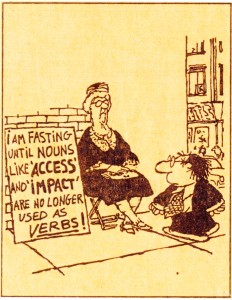

Found Maria, Still Looking for Antonio — An Update
 Our recent story of the migration of my grandparents, Antonio and Maria, from Southern Italy a century ago has generated a fair amount of discussion. Piecing together their journey has been like assembling a jigsaw puzzle with several pieces missing. That first picture was assembled from fragments — sketchy stories from sources living and dead, old photographs, and a sprinkling of facts. Since that first story appeared, we now believe we can paint a clearer picture of when their journey happened, how it happened, and why. The following is ‘Version #2’ of that story based on some renewed recollections, adjudication of some contradictory stories, new online research, and a little luck. One central piece of the puzzle remains lost and I’m still looking.
Our recent story of the migration of my grandparents, Antonio and Maria, from Southern Italy a century ago has generated a fair amount of discussion. Piecing together their journey has been like assembling a jigsaw puzzle with several pieces missing. That first picture was assembled from fragments — sketchy stories from sources living and dead, old photographs, and a sprinkling of facts. Since that first story appeared, we now believe we can paint a clearer picture of when their journey happened, how it happened, and why. The following is ‘Version #2’ of that story based on some renewed recollections, adjudication of some contradictory stories, new online research, and a little luck. One central piece of the puzzle remains lost and I’m still looking.
In our imagination, let’s rewind the story of Antonio and Maria, not back to the beginning quite yet, but back to a time and place where we have recently ‘found’ Antonio’s family. The date is August 18, 1910. On this day, we meet Maria with her two sons — twelve-year-old Giovanni (John) and four-year-old Giuseppe (Joseph). We find them on a ship called The Regina d’Italia, on the last day of a voyage that took them from Naples, across the Mediterranean, through the strait of Gibraltar, and across the Atlantic. Since they were below-decks in steerage, they were unable to watch the approach of a 23-year-old Statue of Liberty as they entered New York Harbor. It wasn’t until the ship docked at Ellis Island that they were able to climb up the stairs to the main deck and get their first look at the ‘Lady in The Harbor,’ who had invited them.
So, how do we know for sure that they were on that boat on that particular day?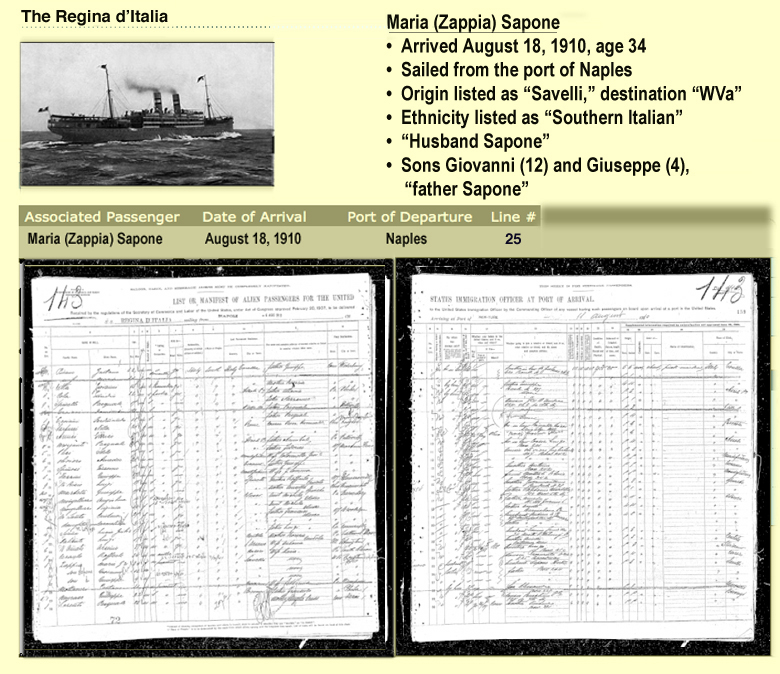
On line 25 of the passenger list for the Regina d’Italia for August 18, 1910, we see something that we had not seen before when searching under Maria’s married name. Under her maiden name, we find three pieces of information that confirm that this is ‘our’ Maria:
1. “Zappia, Maria G.” — Her point of origin was listed as the village of Savelli, consistent with my Aunt Isabel’s story, and her age, 34, is the right age for ‘our’ Maria. She was born in 1876.
2. On the facing page, we see the annotation “Husband Sapone” — this is ‘our’ Antonio, but he is not a passenger on this ship. This is consistent with Isabel’s disputed story that Antonio came to American first.
3. Beneath this entry, on lines 26 and 27, the clincher: we see listed her two sons, Giovanni (Age 12) and Giuseppe (age 4) — father’s name: Sapone. They are the right age and have the right names, traveling with their mother whose name was listed as Zappia. — ‘our’ Maria’s maiden name.
The ship, by the way, had room for 120 1st-class passengers and 1,900 in ‘steerage (where Maria and the boys traveled). Coincidentally, The Regina d’Italia served as a hospital ship after the earthquake at Reggio/Messina.
Still Looking for Antonio
So, now we get to the tough part of the story. It has become clear that my grandfather did not arrive at Ellis Island on the Konig Albert on April 27, 1910, as previously reported here. A closer look at the hand-written passenger manifest shows four problems: for this ‘Antonio,’ the closest living relative in the country of origin was listed as his wife, “Mirolina”; it names his destination was “Pittsbugh, Pa”; and it states that he had previously been to that city. So, none of the passengers I have found in this database so far with my grandfathers name match what we now about ‘our’ Antonio.
We do have some evidence that may enable us to close in on him. Since we know that Maria gave birth to my father, Albert (Umberto) on October 10, 1910, in Red Jacket, West Virginia, we know that she was seven months pregnant during this 12-day voyage across the Atlantic on The Regina d’Italia! That fact also dictates that, if Antonio was Albert’s father, he had to have sailed to America no sooner than January of 1910 (in order to have been on the right side of the Atlantic to have participated in his conception).
What Next?
The Ellis Island database has some new search features and there are other sources to explore. We are still looking for answers:
- When did Antonio sail, from which port, and on what ship?
- What can we learn about their three-year life in West Virginia?
- What more can we learn about their life in California before Antonio’s death in 1927?
So, I have more work to do — the search continues.
![]()
Looking Back One Hundred Years
‘When’ and ‘Where’ Are Easy, But ‘Why’ and ‘How’ Are Tougher
One hundred years ago — 101 to be exact — my grandfather Antonio, and his wife Maria, left Reggio Calabria, at the toe of Italy’s boot, sailed out of the Mediterranean, crossed the Atlantic, entered New York Harbor, and landed on Ellis Island to begin a new life in America.
By itself, this is not an unusual story. Tens of thousands of Italian immigrants made the same journey during the first decade of the 20th century, many more from Southern Italy than elsewhere. The population of Italian immigrants on the eastern seaboard of America, notably New York and Boston, swelled to a point where, in 1910, more native Italians lived in New York City than in the Italian cities of Florence, Venice, and Genoa combined. A popular expression in Southern Italy was: “Chi esce riesce (He who leaves succeeds).”
I had heard bits and pieces of the story all my life — how Antonio, who was illiterate in two languages, couldn’t make himself understood well enough to communicate his own name. When the only job he was able to get was in a coal mine in Red Jacket West Virginia, he was known, and paid, as Tony Sabo. My father and his brothers later learned that wasn’t their name.
He had been part of a Calabresé family who grew citrus and grapes and made wine and, apparently came to America to do the same. According to the family story, Antonio was at a grocery store in Huntington — the town next to Red Jacket — depressed that he had left behind farming and wine-making to work in the coal mine, asked the Italian-speaking shopkeeper, “Where did this orange come from?” The answer determined his future and the future of my father, myself, my sons, and their children. The shopkeeper said, “California.” Antonio replied, we are told, “I am going to California, my boys are not going to grow up in the coal mine.” So, Antonio moved his wife and three sons to the southern end of the Santa Clara Valley — Morgan Hill — where he became a share cropper, grew oranges and grapes, and made wine. It was 1912.
By the 1920s, with prohibition in full swing, Antonio was living his dream (right). According to the story passed down to me, people came from miles around to buy his high-priced oranges, but he gave the wine away for free. By 1925, his youngest son, Umberto (Albert, who would become my father) was fifteen.
So, Antonio — all four-foot-ten of him — had gotten himself to California. Curiously, though, Antonio did not fit the pattern of the historic wave of Italian immigration he had joined. Many came to America to escape poor economic conditions in the south but, according to reporting at the time and more recent scholarship, most came as migratory workers, intending to stay only long enough to take advantage of high-wage (for them) city jobs, send money home, and return to Italy wealthier than when they left. In fact, 20-30% of immigrants from Southern Italy during the period 1890-1924 did just that. Most came to America without their families. Many others eventually ended up staying, sent for their families once they had found stable big-city jobs, an made significant contributions to the cultural fabric of American cities. But fewer came here to pursue lives similar to what they left behind.
The Questions
So all of this has stimulated some puzzling questions. Why did Antonio not fit the pattern? Why did he not settle in the city to work as so many others had done? If his goal was to be a farmer and winemaker, why did he end up in a coal mine in West Virginia for three years? Why did he travel to the other side of the North American continent to grow grapes and oranges and make wine, when he had already been doing that in Calabria? What sent him half way around the globe to make a life exactly like the life he left behind? Why? Nobody had answered that question to my satisfaction . . . until my nephew Joe (‘Joe III’ in the comments) did some digging on the Internet and learned something that none of us had heard before. I think it may shine some light on some of the questions: why he came to America early in 1909, how he got here, and why he stayed.
The Disaster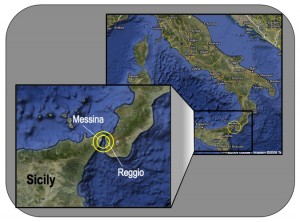
In 1909, J. Martin Miller, published a contemporaneous account of what he called “a disaster more awful and far-reaching than all of Nature’s disasters combined during the century preceding this one.” The cover of his book displayed a long and melodramatic title: The Complete Story of the Italian Earthquake Horror — The World’s Greatest Disaster — Death and Ruin By Earthquake, Tidal Wave, and Fire. His account, still credible after 100 years of analysis, was that more than 200,000 people died in Reggio and Messina, on either side of the Straits of Messina where the earthquake was centered.

Rescuers turned attention to the living, leaving the burial of the dead until the arrival of more help (Miller)
Some Answers
So what does this historic disaster have to do with my questions? Antonio did not seek out the big-city jobs that so many Italian immigrants pursued because be was not qualified — he was an illiterate farmer who couldn’t write his name. So, what future did he think he would have here? He brought his young family, even though he could only get work in a coal mine, because he had no intention of returning home to Italy . . . because there was no home to return to! The entire area around Reggio Calabria was utterly destroyed on December 28, 1908, in the 7.5-magnitude earthquake. The entire region was rubble on both sides of the Straits of Messina. According to Miller’s reporting, thousands of bodies were strewn about unburied for weeks, causing additional thousands to die of disease. All the buildings they had known were flattened. From his point of view, the home he knew no longer existed.![]()
===================================
Epilogue — How Much of This Story Is True?
The details of the earthquake of December 28, 1908, are well documented. Type into Googgle ‘Reggio, Calabria, Messina, earthquake’ and you will find a wealth of detail and the dramatic reactions from around the world at the time, including international rescue efforts much like those taking in place in Haiti today. The contemporaneous Miller book (shown at right), while overly melodramatic in the journalistic style of 1909, is full of details that reflect the reporting from that time and place and dozens of photos that provide some vivid context for understanding the magnitude of this disaster.
The details of the life of Antonio and Maria are accurate in the general outline — not much more is known. However, the feelings and aspirations that drove them — except perhaps for his reaction to the piece of fruit he found in a grocery store in Huntington — can only be surmised. Their generation and their children’s generation in our family are mostly gone, those who remain recall that they never talked much about what happened before ‘the crossing.’ When I was growing up, I heard from my parents that Grandpa “was an orphan.” When asked for details, my aunt Kitty (fourth child of Antonio and Maria, born in West Virginia after my father) told me a summary of what she had heard: “Half the town died,” she said. “All of his family died but him and all of her family died but her. So, they got on a boat and came to America.” When I asked my mother, she said only, “It must have been something like malaria.” Another aunt, Isabel, told me that she thought Antonio had come first and Maria and the two boys came later.
As I’ve researched this story, one problem has been a nagging disappointment. I studied a great resource for families of immigrants — the Ellis Island Foundation website (http://www.ellisisland.org). This terrific service allows you to search passenger lists, and even view the actual hand-written ship manifests, of commercial ships that brought immigrants to the US. We know that Antonio and Maria came to America by ship by 1910 (since their third son, my father, was born in West Virginia in 1910), but I have found no entries on any of the passenger lists of those ships that could have been ‘our’ Antonio, in either 1908, 1909, or 1910. His fairly common first and last name appeared 25 times, but all were the wrong age, came from the wrong parts of Italy, in the wrong years, and with other ‘wrong’ details. The closest match was one Antonio with the right last name who came from Montebello (500 miles to the north) in April of 1909, departed from Naples, was too young to have a nine-year-old son (and too young to have died in 1927 at the age of 56), and identified his marital status as single. Why is ‘our’ Antonio missing from those ships? I’m still working on a hypothesis. Conflicting stories will have to be sorted out. It will have to remain a work in progress for now.
🙂 I hope everyone who is interested in this story will read the ‘Comment’ below from my nephew Joe III. From his own research, he has added significantly to the story; and I appreciate his input tremendously.
Grace — What Child Is This?
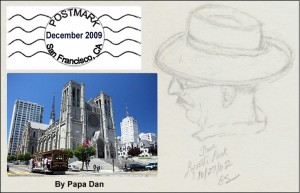
San Francisco, CA — This time of year, as the temperature drops and the earth gets ready to rest for a season, we find ourselves preparing feverishly to celebrate the holidays. For some, holiday celebrations are comforting in their permanence — many among us maintain family traditions, often religious, that remain unchanged for generations.
For others, each new emerging generation brings its own sense of celebration to the season — the tastes and smells, sounds and images, rituals and stories. And so, for many of us, our experience of the winter holidays changes over time.
For us, Papa Dan and Grandma Gretta, an enduring tradition is a day focused on the inspiring music of Grace Cathedral, at the top of San Francisco’s Nob Hill. There is much that has drawn me to Grace cathedral. First and central is the music of the annual Christmas Concert of their Men’s and Boys’ Chorus (all volunteers), orchestra, and pipe organ. Under the current direction of Benjamin Bachmann, the music is a fabulous celebration of Christmas —surrounding their signature piece, Sleeps Judea Fair, with tunes that span the space from the Flemish traditional Cradle Song, to the 16th-century Latin Gaudete, 18th-century Mendelssohn (Hark, the Herald Angels Sing), 19th-century French traditional (Masters in This Hall), to mid-20th century compositions and arrangements by the famous John Rutter (like The Holly and the Ivy) — most of which you would recognize when you heard them. At the mid-point of the evening, while the young and old voices take a rest, a string quartet performs something familiar, usually a classical holiday piece from Mozart, Handel, or the like. This night, however, we were treated to a version of What Child Is This? that got me to thinking about what really draws me to this music and this cathedral at this time of year. More than just the birth of a particular baby 2000 years ago; more than the attraction of a modern cathedral built as an integration of “Gothic” architecture and the humanistic tidal wave of the Italian Renaissance 500 years ago; plunked down 100 years ago in the middle of a very secular, very humanist West Coast city. This holiday at this cathedral is much more.
The cathedral community itself is devoted to a remarkable motto: “We believe in one God, known to us in Jesus Christ, also known by different names in different traditions. We seek to challenge and transform the world, beginning with ourselves, and to celebrate the image of God in every person. We are a house of prayer, worship, and service for everyone, welcoming all who seek an inclusive community of love.”
What does this say to me? It says that the Grace cathedral community believes in a God that is known to them in a certain way, embodied in a particular person with a long tradition, AND at the same time recognizes that others believe in a God that may have different names, different traditions, and is great enough to be included in a much wider community. This particular community calls itself “a house of prayer for all people.” While it is the cathedral church of a particular diocese of a particular Protestant denomination in California, it takes responsibility for being a destination for tourists and pilgrims, a focal point for the community during times of celebration and mourning, a parish church to a vibrant, inclusive resident congregation, and “home” to hundreds — hundreds — of homeless people who sleep in its basement every night— every night — of the year. It is a place that has hosted preachers from Bishop Pike to The Reverend Dr. Martin Luther King Jr. It is a living repository of great art, from the “Art in Glass” of its famous storytelling windows; to Ansel Adams’ unique Grace Cathedral series of photographs, to the “Bible in Bronze” of its front door —the world’s second copy of the famous Gates of Paradise (so named by Michelangelo), the 15th century masterpiece by Lorenzo Ghiberti that began the Florentine Renaissance at the cathedral of Santa Maria del Fiore, ‘Il Duomo,’ in Florence. Ghiberti’s doors are significant in that they depict scenes that are shared by the three world faiths of the west; Judaism, Christianity, and Islam.
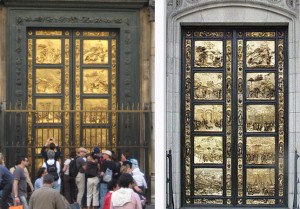
Ghiberti's Doors: Florence (left) and San Francisco (right)
But I digress . . . What does all of this have to do with an unusual rendition of What Child Is This? that I was talking about a few paragraphs ago? Let’s review it and give it another listen. After an energetic, but fairly traditional, first run-through of the very familiar “Greensleeves” tune, a second rendition of the melody seemed to ask a very different question. The original song that we all grew up hearing asks in amazement what kind of child can attract such attention from three wise men from the east, shepherds and their flocks, stars pointing the way, and angels singing. The answer it has always offered is that “the babe, the son of Mary” “is Christ the King.” The second time through, however, these four talented musicians, playing three violins and a cello, used the Jeremy Cohen arrangement, which dropped down into a minor key, leaving behind the certainty of the original piece and giving the cathedral audience a more questioning, inquiring, wondering impression.
So, after twenty centuries, do we here and now understand “what child” can come to the rescue of a weary and troubled world? Does the song, rendered in this way, ask us only to look back in awe at a child born so long ago to in troubled time and troubled homeland? Is it possible that the child — the children — that are our salvation and our hope in these troubled times are those children born to our young parents right here and right now in our own cities across the world?
I recall when Father Jim Keeley, years ago, preached in church that we should focus on “the reason for the season,” which in our own religious tradition was so obvious to us back then. I can’t help but think that, for me, Papa Dan, just another average grandfather to five little ‘hopes for the future,’ perhaps ‘the reason for the season’ can take on a broader, more familiar, more hopeful face.

A 'Reason for the Season,' like yours, just one of mine
My wish for all of you, so generous with your time to read this little page, whether for you it is Christmas, Hanukkah, Al-Hijira, Kwanzaa, Winter Solstice, or Festivus (for the Rest of Us), is that your own ‘reason(s) for the season’ will be happy, healthy, and safe as you summon traditions — old and new — to prepare the way for the coming of the future that will be in their hands.
∞ ∞ ∞ ∞ ∞ ∞ ∞ ∞ ∞ ∞ ∞∞ ∞ ∞ ∞ ∞
For more information about the history and art of Grace cathedral as it begins its 100th year, take a look at:
http://www.gracecathedral.org/content/arts/ghiberti/
![]()
The Sweetness of Doing Nothing
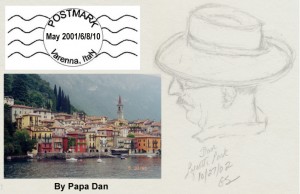
Il Dolce Far Niente
Varenna, Lago di Como, Italia — I am sitting on the terrazzo, watching the ferry boats slide by one at a time across the lake — Lago di Como, a bright blue jewel in Italy’s northern lake region. The sun is trying to get behind the mountain across the lake from us, but finding it slow going. No hurry. There is wine in the bottle. Dinner is in an hour — il dolce far niente, “the sweetness of doing nothing,” is in full flower.
Every quarter hour or so, a large goose on the fishing pier announces the joy of this place in a long, deep honk. No need to disturb the sound of lapping water more often than that. By now, the ferry that launched ten minutes ago from just to the right of my balcony is reaching the point across the lake where a decision must be made: either to put to the right into Menagio, Varenna’s more businesslike twin, or to turn left and wander down the left leg of the lake toward Bellagio, its more famous and fashionable cousin. This one, the Ghisallo, simply makes a wide mid-lake U-turn and returns straight for my balcony before angling back to the dock to my right. Tourists . . .
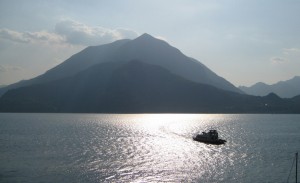 So, how does a day in Varenna begin? After breakfast, when we turn and walk away from this view — back through our bright sunlit room, down spiral stairs, through the colorful lobby, and out into the narrow alleyways that pass for streets here — I find a town interested mostly in itself. While the newspapers are full of national politics, the Italians here have a much more local focus. The headlines describe the impassioned chaos that has caused Italy to elect and dissolve more than fifty governments since WWII; but the local chatter is about the weather and the tourists, the gelato and the children, and who has a new fishing boat. Looking across the red tile rooftops of this town it is easy to see why the 800 people who live here would have a hard time getting serious about the world outside of their colorful self-contained village and its very own slow-paced business.
So, how does a day in Varenna begin? After breakfast, when we turn and walk away from this view — back through our bright sunlit room, down spiral stairs, through the colorful lobby, and out into the narrow alleyways that pass for streets here — I find a town interested mostly in itself. While the newspapers are full of national politics, the Italians here have a much more local focus. The headlines describe the impassioned chaos that has caused Italy to elect and dissolve more than fifty governments since WWII; but the local chatter is about the weather and the tourists, the gelato and the children, and who has a new fishing boat. Looking across the red tile rooftops of this town it is easy to see why the 800 people who live here would have a hard time getting serious about the world outside of their colorful self-contained village and its very own slow-paced business.
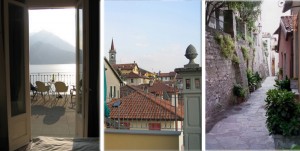
Room #2, red tile roofs, our “street”: XX Settembre
The “business” of the day begins, well . . . late. If a shop posts hours suggesting that it opens at 9:00, you can be fairly sure that it will be ready for you by 9:30. While businesses in America usually post hours like 9:00 – 6:00, or so; here the sign will read something like:
9:00 — 12:00
13:30 — 18:00
The midday break is seldom less than ninety minutes and preparations for midday closing, bringing in the outdoor displays and shuttering the windows, begin around 11:45, shortly after the single gong from San Giorgio’s at 11:30. Sometimes the afternoon doesn’t begin in earnest until 15:00.
So, what do the residents of Varenna do for ninety minutes in the middle of the day? The grocery store is closed. The tabacchi shop, where stamps, newspapers, train tickets, and . . . well . . . tabacchi are sold, is closed. Il pharmacie and il ufficio postale are closed. Il banco, il fiorista, La Villa Monastero — with its beautiful walkways lined with labeled trees and flowers of every color combination — are all closed. Only the pasticceria is open, selling pastries, sandwiches — pannini con formaggio et carne — birra, vino, aqua minerale frizzante, cioccolati, and of course, gelato. So, the logic is clear. At midday, we go to the pasticceria. Until . . .
Seven bells. The announcement comes from the bell tower of the church of San Giorgio, built “probably about 1200” (but first written record of it doesn’t appear until 1313) with four bells, installed in the 17th century, just loud enough to inform this small village that it is time to prepare supper. Click here to see and hear San Giorgio’s bells in action: Bells of San Giorgio — Varenna
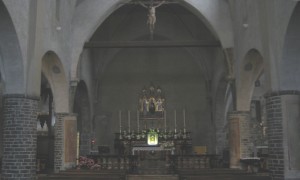 If you happen to walk by San Giorgio’s on your way home and look inside, you will find a simple church, with frescoes of the Holy Family, Saint Christopher, other biblical scenes on the side alters, a small pipe organ, and a very unusual sign, for a church, that greets you in two languages. In English it says:
If you happen to walk by San Giorgio’s on your way home and look inside, you will find a simple church, with frescoes of the Holy Family, Saint Christopher, other biblical scenes on the side alters, a small pipe organ, and a very unusual sign, for a church, that greets you in two languages. In English it says:
“Beauty lives here.
Come in!
But first,
Order your thoughts
And prepare yourself to meet her.”
∞ ∞ ∞ ∞ ∞ ∞ ∞ ∞ ∞ ∞ ∞
As the sun begins to drop behind the mountain, it is time to turn to a more important task: dinner. For a small village, Varenna has a wealth of wonderful food. Most typical is Cavatappi (it means “cork puller”), about twenty yards down our street. It has five tables in a room no larger than my grandmother’s dining room. This is remarkable for a restaurant, considering that in much of Italy, a table belongs to you all evening. So, they serve five magnificent dinners and call it a night. But by far the best food we have tasted in Italy is Egiddio’s cooking right in the restaurant of the small hotel where we have stayed each of our three visits: Albergo Milano. Our favorite table is by far the most beautiful spot to have dinner we have seen anywhere in the world.

Our Table
So, if you’ve observed that not much happened on this day in Varenna, you’d be right. It could be a full-time job if it paid better; but it is not without its compensations. The mind is enriched with simplicity. The eyes are filled with colors, the ears with natural melodies, and the heart with a particular local sweetness. One could do a lot worse than to be a “doer of nothing” in Varenna.
Getting There
• A thirty-minute bus ride from Milan’s Malpensa airport to Milano Centrale train station
• A breathtaking 55-minute train ride from Milano Centrale to tiny Varenna-Esino station (watch for it, the train stops for ONE minute and, depending on how long the train is, you might not see the station when it stops)
• A 5-10-minute walk to any hotel in town.
Staying There:
(We are returning here for the fourth time in 2010)
• Albergo Milano is a dream, with some of the best views and food anywhere.
Bettina & Egidio Mallone
Via XX Settembre 35
23829 Varenna, (LC) Italy
E-mail: hotelmilano@varenna.net
http://www.varenna.net
Call from the US: 011-39-0341-830-298
FAX: from the US: 011-39-0341-830-061
Using Varenna as a base of operation:
Look for a future article about the many beautiful places you can visit as day trips from Varenna’s ferry dock: Villa Monastero, Bellaggio, Fiumelatte, Villa Carlotta, Villa Balbianello, George Clooney’s villa in Laglio, the town of Como itself, . . . more.

Varenna’s Ferry Dock & Albergo Oliveda
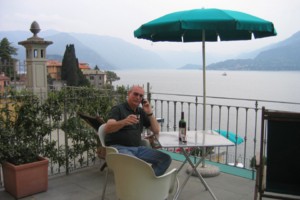
“Buona Sera”
Click here to download a PDF of this article: Varenna_Il_Dolce_Far_Niente
Yosemite — A Place to Stand, A Moment To Savor

Yosemite Valley, California — Thanks to the foresight, eloquence, and hard work of people like The Ahwahneechee, Galen Clarke, and John Muir, the unmatched beauties of this valley can be easily accessible to most of us. But, there are some particularly intriguing views of it that require a bit of struggle. That is fair, of course, given the immense struggle — 20 million years of artful carving by a persistent glacier — that nature endured to form this valley.
On this particular day, Gretta and I are sitting next to a 100-foot tall pine tree in the middle of a meadow about 50 yards from the Ahwahnee Hotel and its five-star dining room. Directly in front of me, Yosemite Falls pours its heart out as it has done since long before human beings stared up in wonder and gave it a name. This magnificent view, one of Yosemite’s most famous, is easy to enjoy — just a three-hour drive from the Bay Area and a five-minute walk from a parking lot to this meadow.
But on Tuesday of this week, we selected a more ambitious project. For decades, I have held a particular admiration for a pair of Yosemite’s less accessible waterfalls — Vernal and Nevada Falls. A pleasant 45-minute walk from the “Happy Isles” bus stop to the wooden bridge across the Merced River allows a hiker to look up at the view of Vernal Falls that Ansel Adams captured in a well-known photograph. That is surely worth the easy hike. But ever since the first time I set foot on that bridge, something has called audibly to me, in a voice from the top of that waterfall. From that first time, it has been clear that the real thrill, and the real achievement, would be to seek out the top of the falls — and a spot from which both Vernal and Nevada Falls are both visible and both audible.
There are two ways to reach the top of the falls from the bridge. One is the direct approach: a sharp left turn after the bridge and a 30-minute climb up what is called the “Mist Trail.” This trail is named for its stairway that climbs alongside the falls — close enough to feel the mist from the falls. This slippery path is most suitable for mountain goats and the most intrepid, sure-footed humans. I took this path years ago when youth and lack of fear gave me confidence that I could reach the top without slipping down the shear rock face to the boulders below. We did not take this path on Tuesday.
The other way is to turn right after the bridge and follow the John Muir Trail on a long winding path around behind the mist trail to the top. We took this path on Tuesday — it is known to be an easier, safer climb.
OK, so let’s define “easier.” For us, this walk entailed four hours of up-and-down switchbacks and narrow ice-filled ledges, some requiring crawling on our hands and knees in the snow.
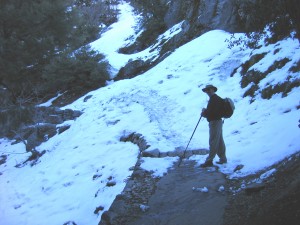
The hike up the mountain was not exhausting, but invigorating, as each turn brought into view a new and spectacular look at the mountain above us and, looking back, an ever-broadening look at the Yosemite Valley we were climbing out of. However, with each passing hour, we reminded ourselves that each step UP the mountain would have to be repeated later on the way down. Our judgment seemed reasonable each time we said, “Well, it would be a shame to come this far without getting to the top.”
So, at long last, one of the turns in the trail rewarded us with the moment we were seeking. Stepping out on a large boulder we looked DOWN at the roaring top of Vernal Falls (as seen in the photo at the top of this essay) and looked UP at its source: gigantic Nevada Falls (below). What a sight! What a place to stand! What a moment to savor!

Nevada Falls
At moments like this, I realize that my most memorable travel experiences have consisted of savoring moments when I have reached a wonderful place to stand — memorable for a range of reasons, from historical significance, to man-made beauty, to sheer natural wonder, like this one. Click here to see and hear a few seconds at the top of Vernal Falls: Top_Vernal_Falls.AVI
The exhilaration of standing on this spot was slowly overcome by a new logic: since it took four hours to get here, it would surely take four more hours to get back. Fear of darkness and the hungry wildlife it would bring out cast a fairly formidable shadow in the bright sunlight of this moment. And, as we began our descent, the aches of already-sore muscles began to make the task ahead seem more and more intimidating with each new switchback and icy ledge. After four hours of uphill and three hours of downhill, the realization emerges that downhill can be much more difficult than uphill for sore muscles and tired feet.
Our twilight arrival at the valley floor was an overpowering mixture of relief and pain. Had this been a good idea? Had we gone too far? I can hear the answer in the voice of the rushing water that called us to that spot above Vernal Falls: “Come and join the beauty, it is worth the struggle.”
It was. ![]()
Music: Greatest Songs of All Time — A Challenge
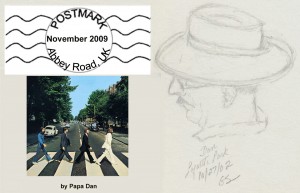
Abbey Road, London, UK — Many of us, young and old, associate pieces of music with the most important aspects of who we are. A few years ago, some of us tried an exercise that turned out to be very interesting. It started when I was asked to list my choices for the Top Five GREATEST SONGS OF ALL TIME. As I made my list, I learned a few things right away:
- I discovered that there were at least 15 songs that I couldn’t drop from my TOP FIVE list
- I learned that “All Time” is a very long time.
- I decided that “songs” had to include a few longer pieces of music not normally called songs.
SO, today I am challenging you (yes, YOU) to create your own “All Time” list. My challenge is to submit a response to this post that answers three questions:
- What is your list of the twenty GREATEST SONGS OF ALL TIME?
- What is wrong with your list?
- What makes your list excellent?
If you will send your answers as a response (click on the link at the end of this post) I will publish them here (with first names or nicknames only). I hope you will accept the challenge. We’ll see what conclusions we can draw from our lists.
I have started the ball rolling with my own.
My Twenty Greatest Songs of All Time
1. Here Comes the Sun — Beatles
(This whole side of Abbey Road IS this song)
2. The Perfect Time to Be In Love — T. Jones and H. Schmidt
(from The Fantasticks, 30th Anniversary Tour) *
3. Me and Bobby McGee — Janis Joplin
4. Sing! Sing! Sing! — Benny Goodman
5. Watching the Wheels — John Lennon
6. Things We Said Today — The Beatles
7. Sleeps Judea Fair — Hugh McKinnon (as sung by Grace Cathedral’s Men’s/Boy’s Chorus)
8. (It’s Not That Easy Being) Green — Kermit The Frog and Frank Sinatra
9. One For My Baby, and One More for the Road — Frank Sinatra
10. Such A Night — Elvis Presley
11. Hope of Deliverance — Paul McCartney
12. Prelude and Fugue in A Minor — Johann Sebastian Bach (as performed by E. Power Biggs)
13. Cantata No. 140: Sleepers Awake (Wachet Auf, choral version) — Johann Sebastian Bach
14. Rhapsody in Blue — George Gershwin
15. Three’s A Crowd — Dave Brubeck
16. Cakewalk Into Town — Taj Mahal
17. Chantily Lace — The Big Bopper
18. When You’re The Best There Is — Chuck Mangione
19. American Pie — Don McLean
20. Maybe I’m Amazed — Paul McCartney
What’s wrong with my list?
- Only one from Elvis
- Only two from Sinatra
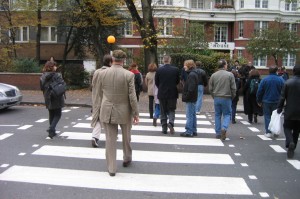
Dan Crossing Abbey Road
- Only one Broadway show tune
- No Moody Blues (John, can you fix that?)
- No Bob Dylan (but how many would it take?)
- No John Mayor and no Pearl Jam (but it’s early and “All Time” is a very long time)
- No Peter, Paul, and Mary (inexcusable!)
- Richie Havens is missing!
What makes my list excellent?
- The Beatles are at the beginning, middle and end (although some claim that the first 126 songs should be Beatles — Jody?)
- JS Bach is represented with both organ and choral pieces
- Athletic achievement is well represented with the Mangione piece
- The Fantasticks is second only to Abbey Road (representing dozens of Broadway tunes that should be listed)
- American Pie serves as a summary and represents some missing artists (Dylan, Stones, Buddy Holley . . . )
- No disco.
What do you think? Please click on “Comments” below and paste in your answers.
I can hardly wait to see YOUR lists. ![]()
* You wonder how these things begin. Well, this begins with a glen. It begins with a season which, for want of a better word we may as well call- September. It begins in a forest where the woodchucks woo, and the leaves wax green, and vines intertwine like lovers; try to see it. not with your eyes, for they are wise, but see it with your ears: the cool green breathing of the leaves. And hear it with the inside of your hand: the soundless sound of shadows flicking light. Celebrate sensation. Recall that secret place. You’ve been there, you remember: That special place where once- Just once- in your crowded sunlit lifetime, you hid away in shadow from the tyranny of time. That spot beside the clover where someone’s hand held your hand and love was sweeter than the berries, or the honey, or the stinging taste of mint. It is September- before a rainfall- a perfect time to be in love.
ConVivio Fiction: Imagining an Alternate History — A Teaching Job
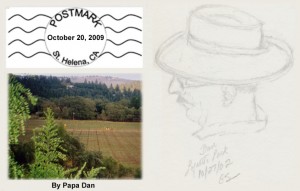
“Have you ever imagined a day that might have put you on a different path — not necessarily a better path, but one that might have been . . . well, interesting.”
Napa Valley Wine Country, California —
“Welcome. I’m happy you could come.” Here at ConVivio Winery, I like to make our visitors feel like invited guests rather than customers. The public tasting room is to the left of this brightly decorated lobby, but these guests had paid for my 3:00 pm. “Estate Tasting”; so I usher them to the right — to the richly appointed Estate Room.
Four couples select high-back oak chairs around a long oak table. I had set each place with six large-bowl wine glasses, a small water bottle, a few apple slices, a salad plate arrayed with wedges of three different aged cheeses, and a dollop of minced garlic/mushroom/olive pâté — all selected to cleanse the palate and provide transition between the wines I will offer them to taste.
Taking my place standing at the head of the table, I wait for my guests to be seated and present the six breathing bottles on the table before me with a practiced flourish. After the first few dozen times, it has become fairly routine and sometimes my mind wanders. As my guests get comfortable in their seats, I flash back over some years to the day that started it all.
∞ ∞ ∞ ∞ ∞ ∞ ∞ ∞ ∞
I came to this valley for the first time on a bus from a lesser-known winemaking region: the Santa Clara Valley. My degree in English literature from Santa Clara University had nothing to do with wine but it did prepare me for three important aspects of this job — writing, speaking in public, and teaching. Growing up, I had acquired from my dad an appreciation for good red wine and a flair for storytelling. Even today, when I wave my hand at the vines and refer to them as precocious youngsters, I realize that I am still my father’s son. After graduating and starting the obligatory search for a career in the local schools, I really just stumbled into the winery business.
Late that graduation summer, three of my buddies persuaded me to tag along on one of those wine-tasting bus tours of the Napa Valley wine country. There was little doubt that the objective was to drink as much free wine as possible without having to drive.
During the first couple of winery tours, I found several wines I liked but the uninspired guided tours, along with the alcohol, made it hard to stay awake: “Yes, here are the oak barrels,” I mimicked on the bus between wineries, “there are the stainless steel fermentation tanks, this is the bottling line, and, oh yes, here is the tasting room. Be sure to check out the gift shop.” I heard myself say, just a bit too loudly, “You know, even I could do better than THAT!”
As fate would have it, the next stop — ConVivio Winery — began as an even bigger disappointment when we piled out of the bus and no tour guide showed up to greet us. The bus driver went inside to check and came out with the news: “Sorry folks. They say the tour guide quit this morning; so there’ll be no tour. But the tasting room’s open.”
Inside the tasting room, I looked up from swirling my glass and noticed my three friends staring at me over their Zinfandel.
“What?!”
“You said you could do it, eh? ‘Better than the others’, you said.” “Well?” The voice trailed off into an accusing silence.
“Come on, that was just . . . you know . . . “
So, “I dare you” was followed by a conversation with the manager, a job application, a few phone calls and an interview over the next week; and three Saturdays later I found myself standing in front of the oak barrels teaching a group of tourists about the art of winemaking.
The job started out to have two major components. I began as the weekend tour guide and, once I learned the vocabulary of the wine business, I was responsible for writing the brochures describing each new vintage, maintaining the ConVivio website, and composing the marketing blurbs that enticed people to sign up for the guided tours and estate tastings.
After the first few months, I began to consider the job to be a teaching job and I thought I was getting pretty good at it. During the week, I took every opportunity to learn the details of the business — I talked to the grower about the vines and berries, quizzed the winemaker about blending and chemistry, and listened to the business manager talk about profit margins and market share. Being the newest employee, I often found myself unloading crates and restocking the gift shop shelves at the end of the day.
Each weekend buses would arrive, tourists would file out, my commentary became more detailed, and my “performance” became more animated. After my first harvest, I came to the conclusion that I really was good at this job and my boss, Umberto di Calabrese, seemed to agree — judging at least by the standard that he kept me around. By the time of my third pruning-to-harvest cycle, I was given the chance to conduct some of the private estate tastings offered by appointment for a fee. Soon, before I knew it, this job that I had taken as a lark was developing all the markings of a real live career.
∞ ∞ ∞ ∞ ∞ ∞ ∞ ∞ ∞
Waking up and focusing back on the long oak table, I took my first real look at the never-quite-the-same-but-always-no-different faces arrayed behind the wine glasses. “My name is Daniel. It is my privilege today to introduce you to some of our favorite wines here at ConVivio.”
During my first few tastings I tried to stick to the “lesson plan” I had prepared. I found I could squeeze quite a lot of information between the pouring and the swirling, the sniffing and the sipping. One Sunday afternoon near the end of a particularly lively session, my boss — Mr. Di Calabrese himself — came into the Estate Room and listened to the last five minutes of my “spiel.” I tried to appear not to notice him as I thanked my guests for coming and began clearing away the last of the glasses and half-empty bottles.
‘Berto, as he was called, had been born in Manarola, a small fishing village in the Cinque-Terrre on the west coast of northern Italy. He had been raised tending the terraced vineyards along the steep slopes of the coastal winemaking region famous for its Sciacchetrà — a sweet white wine typical of the Cinque-Terrre appellation. A California education had bleached out all but the barest remnants of an Italian accent and helped him graduate to the robust dry red wines that he was so proud of today. He poured himself a glass from the last of the Zinfandel and sat down at the end of the long table. “So, Daniel, what did you learn today?”
I lifted a blank look from my tray of glasses.
“Learn?”
“Yes, what did you learn? Who were your guests? Where were they from? What did they like? What did they pour out? What questions did they ask?”
I set down the tray. “Well, the couple who sat here bought a case of the ’04 Cab. The man with the German accent bought a bottle of the Merlot.”
“But that’s not what I asked you. Some people feel obligated to buy something after taking up your time, so that doesn’t tell you much. What did they think of the meritage?”
“I told them it was 60% Zin and 40% Cab Franc.”
“How did they think it compared to the ’05 or the ‘04?”
“Well, they didn’t say. I gave them a lot of the chemistry. I mentioned your barrel rotation strategy.”
During a long pause, ‘Berto looked at me, down at the wine in his glass, then back to me. His expression was kind, but I had the feeling I had said the wrong things. “Why do you think we offer these Estate Tastings? What’s in it for us, dyathink?”
My grin was my best attempt at a look of wisdom. I said, “Two reasons: to teach the tourists about our wines and to earn the thirty dollars we charge them for the tasting.”
Albert smiled a smile that DID convey wisdom and said, “When I was your age, that’s what I thought. The thirty dollars doesn’t even pay your salary and they can read the information you tell them in the brochures you write. We hand them out in the lobby, right? We do not offer the Estate Tastings to teach them anything. We offer the tastings to LEARN from them.”
Albert savored the last swallow of the Zinfandel in his glass. While I tried to hide my embarrassment, the old winemaker got up to go with a look of pleasure on his face. “Be patient with yourself. It took me ten years to learn what you learned today.”
That is my story; and some of it is true. ![]()
Welcome to ConVivio — A New Winery and A New Blog
A Grand Harvest— Picking Grapes with Grandchildren
“Happiness is being one of three generations picking grapes together to make your own wine.”
As a grandpa — they call me Papa Dan — I am privileged to have lots of three-generation experiences; but I have to say that tromping around a vineyard with grown children and wide-eyed grandchildren is among the most satisfying of them.
Last month at the first official harvest of our own ConVivio Winery, our grandson Hayden represented the third generation to participate in our family’s amateur winemaking enterprise. All four of our sons and their ladies, and four other grandchildren have been involved in one part of the process or another, as represented by Gretta’s painting “The Harvest” (below), which will be featured on the labels of our 2008 Festival Red and our 2009 Syrah and Cabernet Sauvignon, currently in barrels.
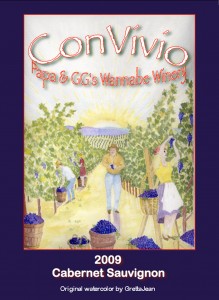
But, on this October 2009 harvest day, Hayden became the first of the grandchildren to actually pick grapes. He was quite a sight dumping his brightly colored toy sand buckets full of the grapes he had picked into his red toy wheelbarrow, wheeling up to the back of the truck where I was feeding grapes into the crusher. With the serious expression of a little boy who knows he is doing grown-up work, he looked up at me and said, ”Here ya go, Papa Dan, I picked some more grapes for you.” I know that my father tromped around in his father’s vineyard as a boy, but as far as I know, I am the first grandpa in the family to make wine from grapes picked by his grandchildren.
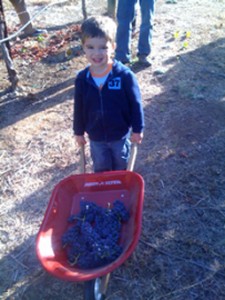
∞ ∞ ∞ ∞ ∞ ∞ ∞ ∞ ∞
Grapes are amazing — a pure product of soil, air, water, and sunshine. The ancient Greeks spent a lot of time in vineyards and it is no wonder that they concluded that all of nature was made of four elements – earth, air, water, and fire – the four things necessary for producing grapes. Humans didn’t discover yeast until 1857 (Louis Pasteur) , but their observation that nature conspired to turn grapes into wine from these simple elements, led them, at least, to get the big picture right — evident in that wise men over many centuries (Benjamin Franklin among them) have stated the obvious truth: “Wine is evidence that God loves us and wants us to be happy.”
The process of gathering generations together to pick grapes, make wine, and bottle it — and then pour it back out of the bottle when the time is right — has always been the background music of my family.
My father never made wine, but passed on to me his appreciation of it, which he learned at the knee of his winemaking father, who brought his winemaking experience, acquired as a youth in southern Italy, to California one hundred years ago and grew grapes and citrus and made wine in the Santa Clara Valley. According to the family story, all through prohibition, “people came from miles around to buy his expensive oranges; but he gave the wine away for free.” So, we have a wine-making heritage.
∞ ∞ ∞ ∞ ∞ ∞ ∞ ∞ ∞
So, here we are, one foot in the 21st century, the other back in the 19th and beyond, still making wine, enjoying each other’s company trudging through vineyards, crushing the grapes, tasting from the barrel, filling the bottles, and seated around dinner tables lifting glasses in celebration of the wonderful and ordinary days we spend together.
We have named our winery ConVivio. In Italian, it means “festival.” In English, it derives from words like welcoming, friendly, lively, and hospitable — literally “with life.” With this Blog, we intend to celebrate all things related to that theme. Our media will include fiction, non-fiction, art, travel, music, food, and wine — not necessarily in that order. My goal is to write two columns a week. You are welcome to participate by reading what you find here and, if you feel the urge, responding with your own comments and contributions. We hope you will join us here often.
Click on the word “comments” just below this post to leave a response.
![]()

